
Find anything, super fast.
- Destinations
- Documentaries


How Artificial Intelligence Could Transform the Yachting Industry
By Frances Flannagan
Artificial Intelligence (AI) is undeniably becoming more prominent in our everyday lives. Its development has now reached the superyacht industry, with IYC being the first company to introduce AI to yacht management.
Whether you fear it or are for it, there is no denying the fact that Artificial Intelligence (AI) is creating endless possibilities within the world that we live in. This limitless potential extends to the yachting industry, an industry known for its luxurious nature and its place amongst society’s elite. From trip planning to fuel calculations, AI has the potential to completely reshape the industry, moving us into the future of yachting.
What was once mere speculation has become a reality: IYC is the first company to introduce AI to yacht management. They have created a software named BLUE which seamlessly ties all yacht management operations together, streamlining life onboard. It is a market-leading yacht support software system exclusive to IYC, having already proved popular with owners and crew as it is straight-forward to use, increases efficiency and ensures compliance.
Anna is BLUE’s AI Yacht Manager; she handles administrative tasks and compliance requirements whilst guiding crew, owners and managers. She operates as a ‘virtual yacht manager’ ensuring increased safety on board.
Celine Robins, the Global Yacht Management Director of IYC, has commented on the significance of BLUE: ' This is the first time in the world that artificial intelligence is brought into the yachting industry and to yacht management. That is extremely revolutionary. Artificial intelligence is going to reshape our world.'
In a recent announcement, Robins proceeded to provide insights into the significance of BLUE not only for the industry, but for IYC and for clients. She recognised the reduction of costs as well as no more human errors, both benefits for IYC. She believes that more focused work due to the simplicity of the software will result in increased consumer satisfaction, ensuring repeat clients for the vessels.
The benefits for the owner are also cost-related; the preventative maintenance provided by BLUE will save the owner a lot of money as yacht checks and services will be carried out regularly and on time.
The future is undeniably bright with BLUE; as the software grows and AI becomes more prominent in our everyday lives, there is limitless potential and endless possibilities for virtual solutions.
"This is the first time in the world that artificial intelligence is brought into the yachting industry and to yacht management. That is extremely revolutionary. Artificial intelligence is going to reshape our world." Celine Robins, Global Yacht Management Director, IYC
"This is the first time in the world that artificial intelligence is brought into the yachting industry and to yacht management. That is extremely revolutionary. Artificial intelligence is going to reshape our world."
Related News
Featured events.
- (954) 633-4878
- [email protected]
Gulfstream news
- May 6, 2024
AI Afloat: The Role of Artificial Intelligence in Yacht Systems

Exploring the Impact of AI in Modern Yachting
Artificial Intelligence (AI) is revolutionizing many industries, and yachting is no exception. The rise of AI in this sector is not just about adding luxury features; it’s primarily focused on enhancing efficiency, safety, and the overall experience at sea. By integrating advanced AI, today’s yachts are becoming smarter and more intuitive to the needs of those onboard.
Enhancing Navigation with AI
AI-driven systems are a game-changer for yacht navigation, offering more precise and safer passage planning. These intelligent systems process data from various marine and weather sources to suggest the best routes and avoid potential hazards. This technology reduces the burden on human crew members and enhances safety by minimizing the risks associated with human error.
Predictive Maintenance: A Proactive Approach
One of the biggest advantages of AI in yachting is predictive maintenance. AI systems continuously analyze the performance data from various yacht systems, predicting potential failures before they occur. This ensures that all equipment is maintained in optimal condition, preventing unexpected breakdowns that can disrupt trips and lead to costly repairs.
Personalizing the Onboard Experience
AI is taking the personalization of guest experiences to new heights. Smart systems on yachts can learn preferences for entertainment, temperature, lighting, and more, automatically adjusting the environment to suit each guest’s taste. This level of personalization ensures every journey is comfortable, enjoyable, and uniquely tailored to the guests onboard.
Improving Safety Through Intelligent Monitoring
The application of AI significantly increases safety on yachts. Advanced AI systems can monitor the surroundings continuously, detect unusual activities, and provide real-time alerts. Whether it’s identifying a person overboard or detecting potential intruders, AI enhances the security measures onboard, ensuring peace of mind for everyone.
Driving Sustainability in Yachting
Beyond comfort and safety, AI is instrumental in promoting sustainability in the yachting industry. Smart energy management systems utilize AI to optimize fuel consumption and reduce emissions. These systems manage the yacht’s energy use more efficiently, helping to protect the marine environment while reducing operational costs.
Fly Yachts: Your Trusted Partner in AI-Enhanced Yachting
At Fly Yachts, we understand the transformative impact of AI on the yachting experience. As a leading yacht brokerage, we are committed to staying at the forefront of technological advancements, ensuring our clients benefit from the latest innovations in yacht systems. Discover the future of yachting with Fly Yachts, where advanced AI meets exceptional maritime expertise.

Fly Yachts is your one-stop shop for all your yachting needs, whether you’re buying, building, or exploring the seas. Check out our yachts for sale if you’re interested in purchasing a yacht. If customization is what you’re after, our build a yacht service allows you to create a yacht that perfectly fits your lifestyle. For those looking to explore, we offer numerous thrilling charter destinations . Discover all we have to offer on our homepage and learn more about our values and team on our About Us page. Planning to sell your yacht? Our sell your yacht services can help you efficiently manage the sale. Stay informed with our Compass Articles , perfect for those who crave knowledge on yachting trends and insights. Aviation enthusiasts should not miss our aircraft for sale . Keep up with the latest news by visiting our Gulfstream News , and if you have any questions or need assistance, don’t hesitate to contact us . We’re here to help you navigate the extraordinary world of yachting.
About FLY Yachts
Recent posts.

Eco-Friendly Yachting: Green Innovations in Yacht Design

Echoes Below: The Importance of Sonar Systems in Yachting
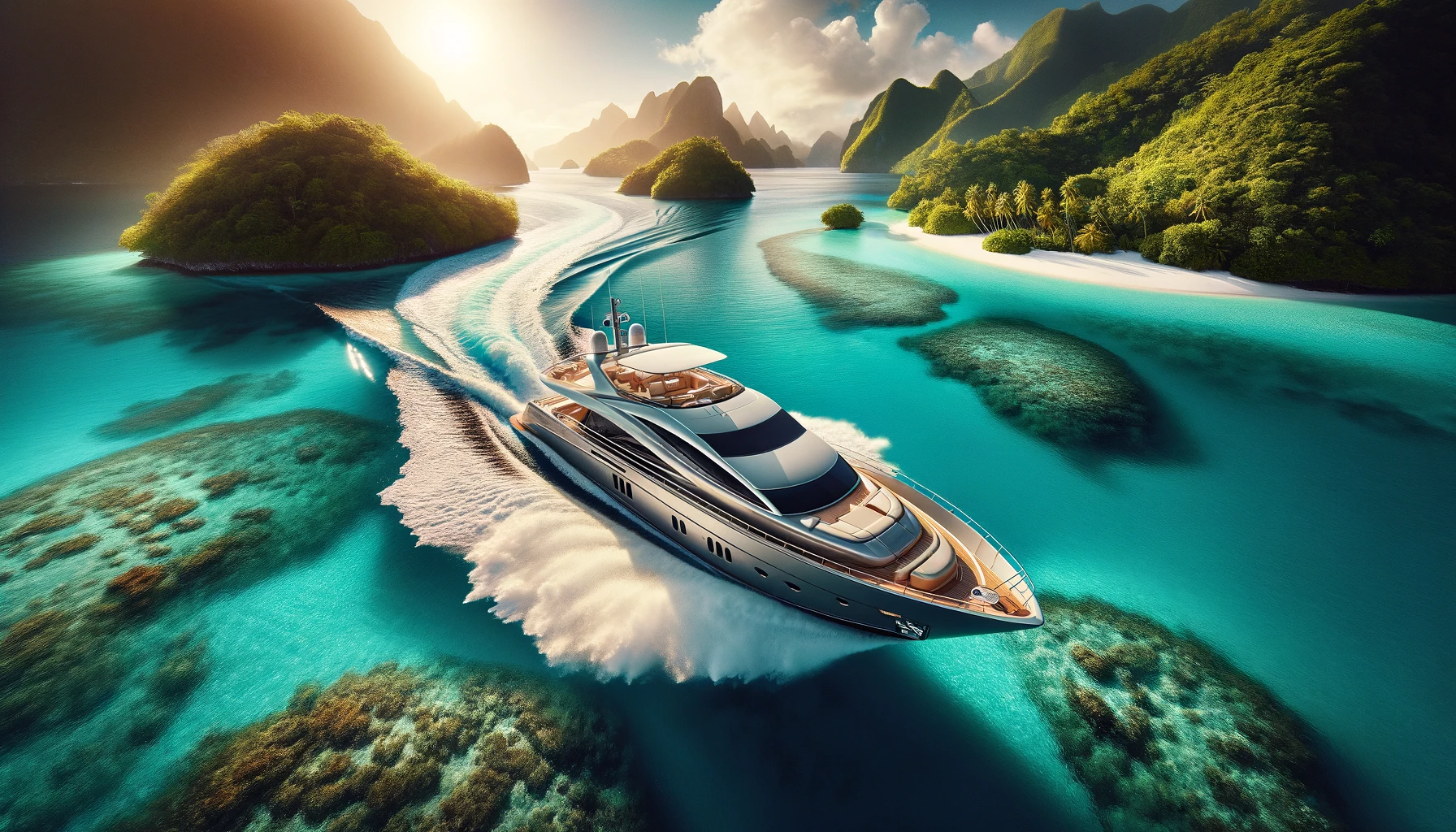
Health Check: Monitoring and Maintaining Yacht Systems

Rossinavi Oneiric
Yachting’s intelligent change
The focus of technology applied to yachts often centres on power and propulsion systems, but pioneering designers and projects are applying it in other ways – from ensuring inclusion to embracing the possibilities of AI.
Since the dawn of Western thought, and likely long before, the idea of technology has engendered various questions – the philosophy of technology, if you will. Such questions, which consider the nature of technology and its social effects, seem at the forefront of our collective consciousness now more than ever. We talk about the impact of technology on our environment and climate, and the role that technology can have in reversing that impact; or the implications of advancing machine learning and the rise of artificial intelligence, and whether those represent an opportunity or a danger to our society.
In ancient Greek philosophy, technology – which derives from the Greek word techne (meaning art, or craft knowledge) – was commonly viewed as arising from an imitation of nature. Our general understanding of technology these days often seems at odds with the natural world, but increasingly things are coming full circle. That is particularly true, I would suggest, in the superyacht sector.

Philippe Briand Photo: Gullaume Plisson
We often talk about superyachting being a crucible of technological development, and it is true that, out of all maritime sectors, yachting has the least commercial pressure to stick to the status quo and the most to gain by seeking new and advanced solutions to the problems of emissions, sustainability and environmental impact. That the superyacht sector is not only drawing on but in many ways leading the charge to a zero-emission and a net-zero future is amply demonstrated by various projects in build that are employing not only diesel-electric solutions, but actively incorporating hydrogen-based power and propulsion systems to mitigate or remove the need for harmful fossil fuels.
But the application of technology means so much more these days than just an approach to systems or propulsion. Unveiled early in 2023, a shortlisted design from Team FestivAL – which combines the talents of Philippe Briand’s Vitruvius Yachts naval architecture office, Zaha Hadid Architects, and aluminium boat specialist Ocea – for a National Flagship for the UK (a replacement for the old yacht Britannia ) draws on a hydrogen-based propulsion system. But this ‘yacht of the people, but fit for a king’ project is also designed to maximise accessibility for people of all ages and all levels of ability or disability. It would feature wall-to-wall displays showing presentations adaptable to the yacht’s given role at the time, and a multi-sensorial experience throughout the yacht that would include sign language and audio descriptions. There is even a modular mission bay aft that can be used for carrying humanitarian supplies or serving as a modular science lab. This is technology with a social philosophy, combined in what essentially is a private yacht open to the masses.
“To design a vessel – a flagship – that will become a benchmark in sustainability as well as demonstrating British excellence and heritage for current and future generations, while also being a symbol of inclusion and diversity, was an enormous challenge that kept me awake at night,” says Philippe Briand. “The nature and intensity of the project kept me focused but also filled me with pride, not just in the design process itself but for what the flagship stands for.”

That’s not the only example of the changing role technology is taking in new yacht projects. When it comes to artificial intelligence – about which the philosophical and technological debate is currently raging – in many ways yachts already bear its evolution as sensors on every element of equipment and system start to analyse status and progression to provide predictive maintenance. For Italian superyacht builder Rossinavi , however, AI forms a far more fundamental element of its yacht philosophy. It is emerging in what the shipyard has called BluE – an eco-centric navigation technology and AI engine.
It has been incorporated in Rossinavi concepts such as the Infinty 42 BluE monohull, the 40-metre Sea Cat motor catamaran, and other designs, and is already being realised with the first Sea Cat under construction, among other projects. This new breed of vessel of course draws on green energy solutions – in the Sea Cat’s case using solar energy to supply a battery bank which means the yacht can operate in full electric mode for cruising and anchoring. It can achieve a transatlantic crossing under electric power alone for 80 percent of the time, with a diesel-electric hybrid system on just 20 percent of the time – a fact, says Rossinavi, that saves 40 tonnes of CO2 on a single crossing compared to a conventional yacht. It can even serve as a giant powerbank when in ‘hybernation’ mode, delivering green power into the shorebased grid or to a private residence.
But it’s the AI element that is really interesting. The system creates an ‘intelligent vessel’ which monitors shipboard habits and suggests behaviours to further save energy. It also adds an infotainment element via a voice-controlled Smart assistant that provides information on places of interest, trivia and local activities. The whole is linked to Rossinavi’s underlying philosophy that takes inspiration from phytoplankton, the essential microbial lifeforce that draws energy from the sun, traps carbon dioxide, and underpins the health of the entire ocean. Techne , or an imitation of nature, indeed.
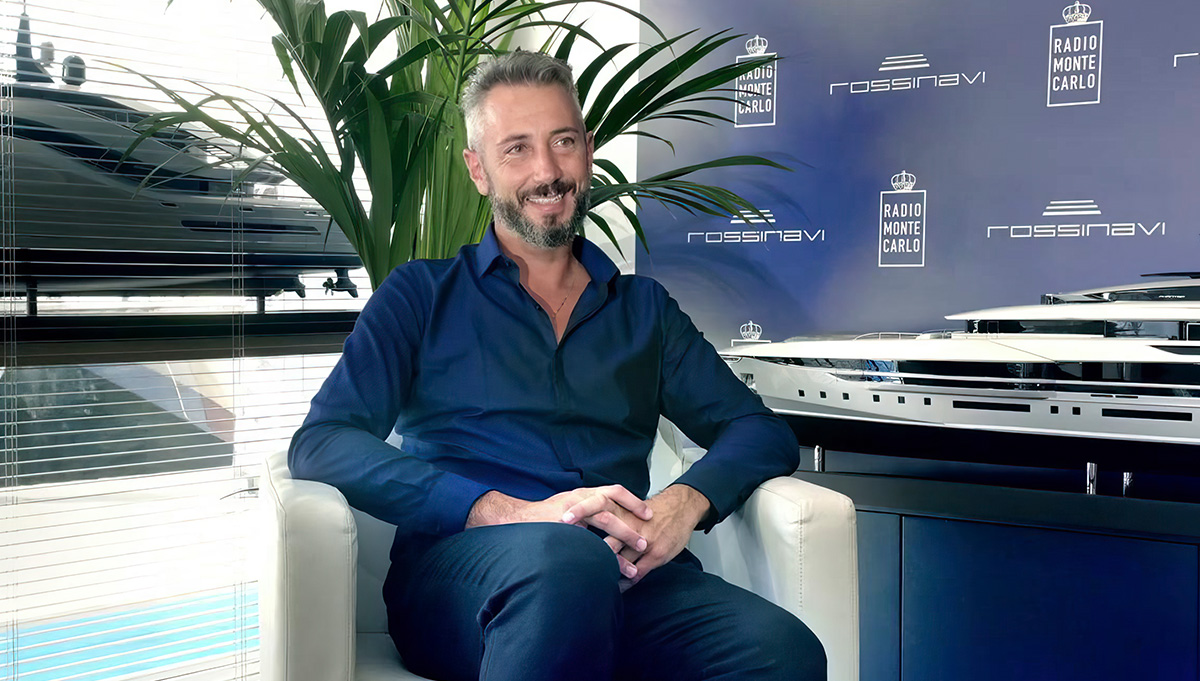
Federico Rossi
“The idea is to create a link between nature, electricity and futurism, which, supported by the most advanced technologies, is able to offer excellent performance to the Sea Cat 40 that offers priority to the environment,” says Federico Rossi, Chief Operating Officer of Rossinavi. “[The] new generation of yachts is moved by a sense of responsibility,” he continues. “I wanted to set the goal beyond the obstacle to build avant garde products that better express our meaning of cruising experience, moving increasingly toward a more sustainable direction.”
For Rossi, it is not just the responsibility of superyacht owners and the world’s ultra high net worth individuals to, essentially, clean up their act, but also to remember that in modern society their actions and their decisions can have a real impact on society at large. It’s why the superyacht industry in general, it could be argued, is making such great strides forward, because we know collectively both the negative effects if we don’t, and the positive impacts if we do.
“In the world of influencers, the wealthy and the billionaires give the common citizen a kind of ideal aspiration, which needs to go beyond the image of an extremely high performance car totally heedless of the CO2 emissions it entails, otherwise we risk giving the new generations that kind of ambition,” Rossi has said. “If these influencers manage to change this approach, we can really improve the world.”
You may also like...
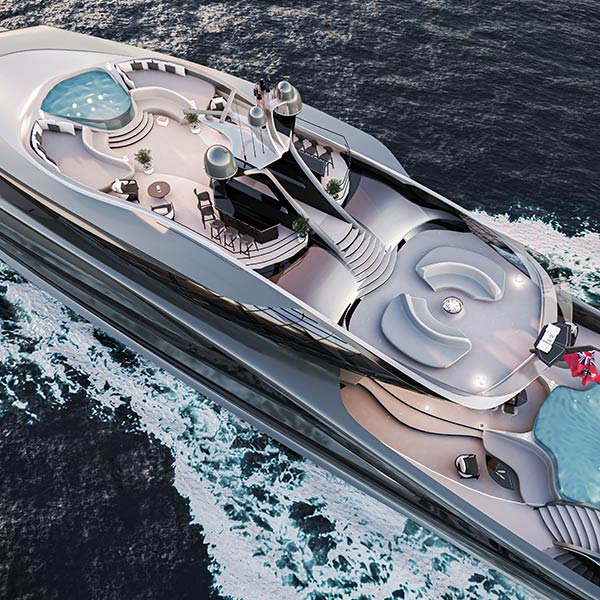
Zero to hero
Advancing technology and growing environmental consciousness are combining to drive change in all aspects of our lives and, as recent projects show, superyachts may well turn out to be in the vanguard of this evolution.

Vienna Eleuteri
Vienna Eleuteri is a sustainability scientist with particularly strong links to the superyachting world. Most recently, she initiated the Water Revolution Foundation, an organisation which aims to neutralise the footprint of the industry.
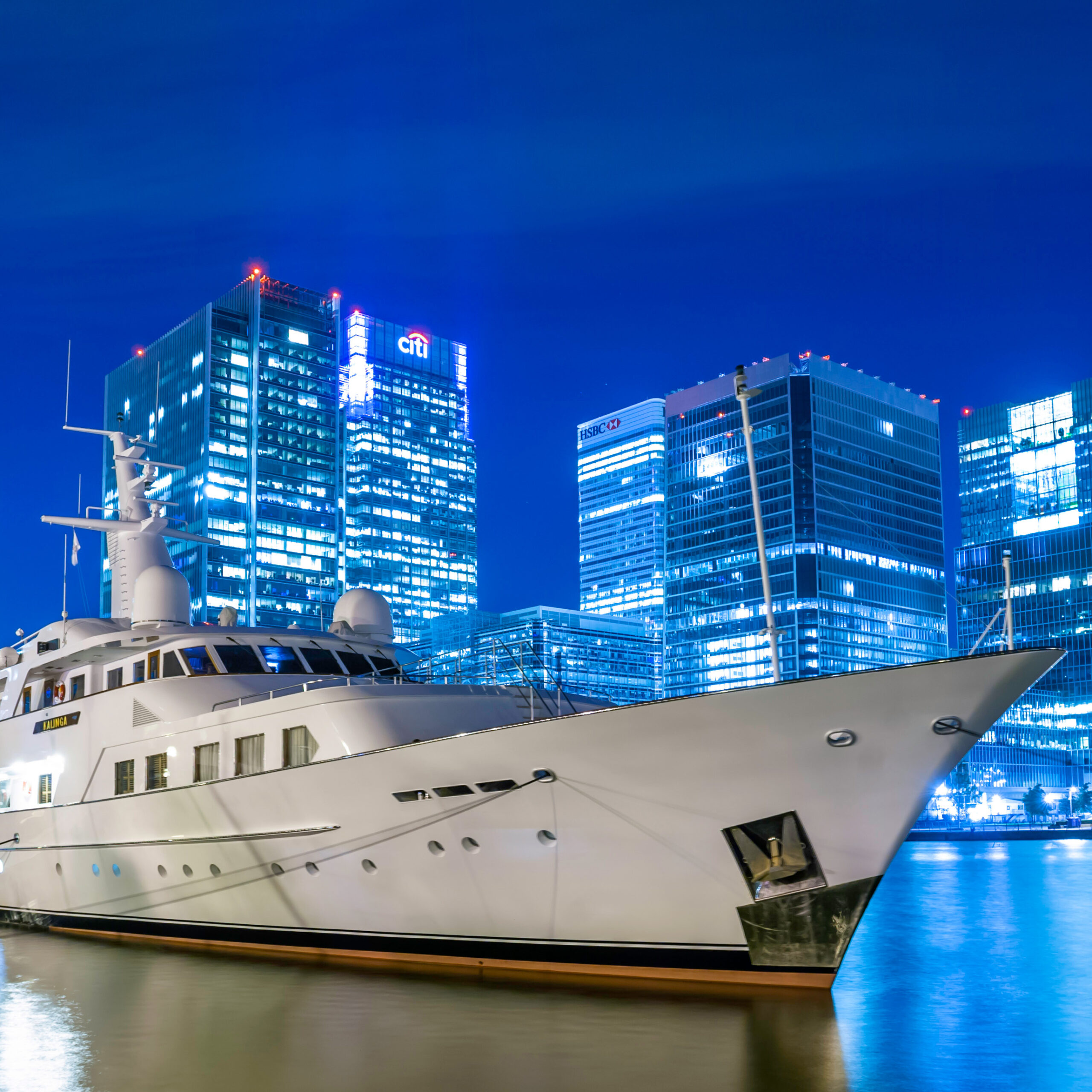
Sharing the superyacht spend
Studies are showing that from charter spend to home-porting, supply, refit and maintenance works, superyachts are not a resource hog – they are a creator of jobs and opportunity.
Do you work in the superyacht industry? Yes No I would like to receive updates from Superyacht Life
Don’t miss out
Sign up to our newsletter and get our latest stories delivered monthly to your inbox.

How AI is Transforming the Superyacht and Business Aviation Industries

For two industries that have much in common, the difference in the adoption of artificial intelligence on private jets versus AI integration on superyachts is stark. While the aviation industry has been using artificial intelligence in its engines for almost 25-30 years now, the superyacht industry is yet to get started.
So, why the disparity between AI usage on large yachts and private planes? After all, the target market for both is similar, with many ultra high net worth individuals (UHNWIs) owning one (or more) of each asset. If the owners and users of business jets are expecting the best and latest technology for their plane, then why aren`t they asking for the same from their superyacht?
To answer this, it's helpful to have some context. “When you analyse the trends you realise how far the aviation industry is ahead of everybody,” points out Joseph Adir, founder & CEO at WinTech Marine Intelligence. Moderating the AI panel at Quaynote's online conference, The Future for Superyachts, Business Jets and Luxury Property, Adir holds up companies like Netjets and JetEdge whose business models are both heavily reliant on AI. “Netjets currently operate 750 planes that have no set flight schedule from one day to the next. They are all shared owners and decide at the last moment where they want to go.”
Where AI comes in is in making sense of this logistical headache. “Algorithms created by Netjets ensure that planes are where they should be, meeting the needs of clients and all in a cost-efficient way,” he explains.

For Joseph Adir, whose company Wintech Marine Technology is creating a predictive maintenance system for superyachts, the benefits of AI go hand-in-hand with sustainability. “There is nothing better than AI to improve your performance, reduce fuel consumption, costs and expenses,” he states. “And yet we still build and design yachts the same way it was done 20 years ago.” Given the increasing awareness by yachts and jet owners alike of sustainability issues, the apparent reluctance in the superyacht industry to embrace AI technologies is perplexing.
With so many compelling reasons for the superyacht industry to follow aviation`s lead, Dominic Bulfin, director at Bargate Murray, threw some light on the differences lying at the heart of this discussion. “One difference is that business jets are largely a tool,” he observes. “The jet is not a luxury in itself and I think that`s an important factor in why there's been a delay in yachts adopting technology.” He wonders if yacht builders should be steering owners towards incorporating AI in their newbuilds, educating them about the potential savings, additional safety, etc., that can be gained without compromising on the beauty of the vessel.

Contrast this with the degree of tech awareness in the private aviation space, where synthetic vision is more-or-less standard in all the leading planes, and a picture starts to emerge. “For OEMs, AI/tech is something they talk about in every sale. They're always trying to out-tech the next guy,” asserts Jeff Lowe.
But is this really a critical factor for the client? “The guy at the back, he's into the design of the cabin and everything else, but he still has an ear for the safety, the systems, the maintenance. What makes for him is the availability, making sure that his plane is available more often than not. So yes, he is interested.”
While both jet and yacht owners expect their asset to be readily available, there is arguably a more personalised aspect to the superyacht business. The customisation of the superyacht itself is a key factor that separates it from the business jet. “Planes are fairly homogenous, whereas each and every superyacht is different from the next. A Boeing 737 is a Boeing 737,” says Joseph Adir. “But, on a yacht the engine, navigation systems – everything – is different and this is the challenge for us.” This high level of differentiation creates the need for a very advanced AI platform, which brings its own set of obstacles for the superyacht industry.

So, if properly handled, there appears to be no reason why the superyacht industry cannot enjoy the same AI successes that business aviation has been able to reap for the last two decades. But who will drive this evolution? Will it be the owners, builders or regulators who will push for change?
Drawing on his own experience in the private jet sphere, Jeff Lowe is clear. “I'd love to say that the OEMs are the single source, but the regulators are constantly pushing the industry to make sure they have the best of the best,” he notes. With regulations less stringent in the superyacht industry than for our aviation counterparts, Joseph Adir thinks it is down to yacht builders to drive the change. “There is no way to educate 7,000 owners one by one,” he reasons.
The good news is that exciting developments are already in the pipeline. The commercial shipping industry reported to be two or three years away from launching the autonomous container ship. Moreover, a fully autonomous yacht, the product of a joint venture between a start-up venture and IBM, is set to sail at some point in the future between the UK and New York. The possibilities for superyacht AI look poised to become reality.

Post your comment
You cannot post comments until you have logged in.
No one has commented on this page yet.
RSS feed for comments on this page | RSS feed for all comments
Search articles with keywords
- Seller Market Analysis
- Trade Your Yacht
- Sold Yachts
- We Buy Boats
- Exclusive Listings
- Yachts for Sale
- New Yacht Builds
- Nautor Swan Yachts
- Sichterman Yachts
- Luxury Yacht Charters
- Search Charter Yachts
- Charter Management
- Luxury Events
- Team Members
- Boat Show Events
- North Report Magazine
- Testimonials
- +1.954.900.9988
Blog | How AI is Transforming the Marine Industry: Implications for Yacht Owners
How ai is transforming the marine industry: implications for yacht owners.
As pioneers in the marine industry, 26 North Yachts is always on the cutting edge of technological advancements, and Artificial Intelligence (AI) is no exception. AI has massive potential in reshaping the yacht industry – from making trip planning a breeze, optimizing fuel calculations, and streamlining yacht management, to personalizing marina recommendations and dockage suggestions. Let’s delve deeper into how AI is moving us into the future of yachting.
AI and Trip Planning in the Yacht Industry
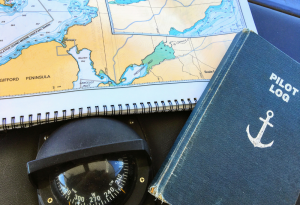
Trip planning in the yachting industry is becoming more convenient and personalized, thanks to AI. AI can analyze patterns from past journeys, including favorite routes and locations, to offer tailored trip suggestions. By considering real-time factors such as weather conditions and tide patterns, AI not only assists with planning a safe trip but also provides an unforgettable yachting experience.
Fuel Calculation Revolution with AI
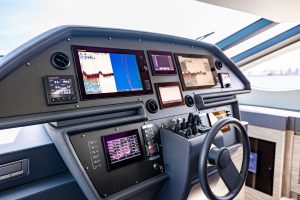
Fuel calculations are a vital part of yachting, yet they can often be complex and time-consuming. AI is stepping up to revolutionize this aspect, predicting fuel consumption based on variables such as speed, distance, and even specific yacht characteristics. By offering optimal routes and speeds, AI can deliver considerable fuel savings, making yachting more efficient and eco-friendly.
AI’s Role in Streamlining Yacht Management
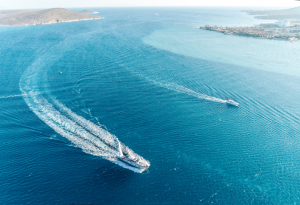
Managing a yacht encompasses various aspects – from routine maintenance and inventory management to crew scheduling. Here, AI proves to be an invaluable asset, predicting maintenance needs, automating inventory tracking, and optimizing crew management. By handling these time-consuming tasks, AI enables yacht owners and captains to focus more on the joy of cruising.
AI-Powered Marina Recommendations and Dockage Suggestions

Choosing the right marina or finding the best dockage can be a daunting task. AI simplifies these decisions by providing personalized marina recommendations and dockage suggestions. It considers various factors such as marina facilities, nearby attractions, user reviews, and your yacht’s specific needs. The result is a hassle-free selection process that aligns with your unique preferences.
Limitless Possibilities with AI Suggestions

The potential applications of AI in the yachting industry are almost limitless. From suggesting on-board dining options based on your culinary preferences to recommending water activities or local events at your destinations, AI personalizes your entire yachting experience. Additionally, AI can enhance safety by predicting potential issues based on weather forecasts and yacht diagnostics, ensuring smooth and safe voyages.
The advent of AI in the marine industry is heralding an exciting era of personalization, convenience, and efficiency. As leaders in this industry, 26 North Yachts is at the forefront of integrating these AI advancements to deliver a superior yachting experience. The future of yachting is here, and it’s driven by AI.
Recent Stories
Embark on a dream voyage: yacht chartering through the bahamas, smooth sailing: essential tips for national boating safety week.

Talk to us Contact Our Team
I understand that by signing up I agree with 26 North’s Privacy Policy .
Welcome aboard!
We have added you to the newsletter.
We have received your information and an agent will get back to you ASAP
Sign up for Yoga On the Docks Tuesdays at 8 AM
We have received your registration. See you on the docks!
WE’RE HIRING DESIGNERS, NAVAL ARCHITECTS, AND PROJECT MANAGERS! CLICK HERE TO ENQUIRE DIRECTLY WITH OUR LEADERSHIP >

DLBA YACHTING NEWS
A superyacht optimized with artificial intelligence in every system.
MARCH 24, 2020
With the rapid advancement of artificial intelligence (AI), the potential for impressive and boundary-pushing progress across all aspects in yachting is at our fingertips. Advancements in automation of vessel machinery, electrical, and navigation systems has an immense potential to improve the yachting experience for all owners. With the immense potential for revolution comes the need for extensive design, engineering, and testing. DLBA Naval Architects is developing a 58m concept superyacht, which thinks through all vessel systems to see where artificial intelligence can take the superyacht experience to the next level. Within DLBA Naval Architects’ Virginia offices, a concept is underway which could change the trajectory of yachting.

DLBA has selected a 58m superyacht concept to develop internally as an autonomous yacht. The result, TEMPO, will be a study in all vessel systems where artificial intelligence can be used to enhance an owner’s experience onboard. The name of the concept is tied to the uptick in operational tempo that the AI will make possible through enhanced reliability and operational availability, meaning that owners and guest will be able to spend more quality time onboard enjoying all that yachting can offer.
There are three main areas where autonomous technology can be brought to bear in the maritime world – navigational autonomy, equipment health monitoring, and mechanical and electrical systems automation. DLBA’s vision is to deliver best-in-class autonomous vessels as the industry-leading vessel designer and autonomy integrator, and it’s expected that, through this process, questions which are already being raised on autonomy will be answered to move this field forward.
Taken alone, any of the three branches of navigation autonomy, equipment health monitoring, and mechanical and electrical system automation can have a profound effect on the operation of a yacht; when designed into the vessel from its conception, that effect can be groundbreaking with respect to maximizing availability and minimizing operational and maintenance costs.
The company’s prior experience with autonomous vessel research and development programs means it’s well-placed to understand the challenges and limitations of this field and has seen it partner with traditional and non-traditional technology providers to push automation for the best
This allows the company agility as it integrates continually-evolving autonomous technology into the concept yacht, the exterior design of which was provided by SDG; and it’s looking forward to working with visionary vessel owners seeking to benefit from autonomy themselves.
Navigation Autonomy
Navigation autonomy relieves the workload on the vessel operator, and unmanned vessels have been operating in the commercial and military space for years. Autonomous navigation systems create an electronic world model, fusing data from onboard sensors, and information sources like GPS, radar, AIS, electronic charts, weather information systems and video cameras to safely navigate both highly-congested areas and open seas.
The operator is left to maintain a presence while the autonomous navigation system guides the vessel. The reduced level of focus required in this area results in higher situational awareness. The benefits to this include a reduced risk of collision and grounding, avoidance of heavy weather, optimization of fuel consumption and lower operator workload.
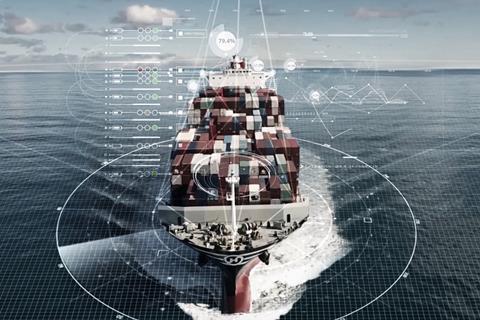
Mechanical and Electrical System Automation
Mechanical and electrical system automation is like having an onboard engineering team at your fingertips. By ensuring elements at the sub-system level are AI-ready, the vessel can be kept operating at peak performance, without any additional workload for the onboard engineering team. Think changes of valve orientation, turning on and off electrical equipment breakers, starting and stopping pumps, or addressing system faults when they occur; all carried out automatically based on the single push of a button. The result is less work for the engineering team and greater reliability of the vessel; and that means more hours of use for the owner.
Capturing and monitoring the data in real time provides advanced diagnostics and prognostics of onboard systems and equipment through the use of sensors and data collection. Trending and machine learning can then be used to provide real time feedback onboard the vessel for almost all systems, which can then be used to identify almost all potential faults in advance – allowing for correction before they occur and maximizing the owner’s use and enjoyment of the vessel.

Cybersecurity
Considering the risks associated with advanced electronic communication and control systems, the vessel is being develop with integrated cybersecurity. Communication channels and mission critical information needs to be encrypted and protected against both malicious and unintentional adverse impact of misconfiguration and data compromises. Hardware and software for autonomy is assessed for vulnerabilities and hardened against potential intrusion attempts.
Unmanned and autonomous solution’s dependence on accurate and timely communication makes cyber resiliency in an autonomous solution a prime security objective. Convergence of information and operational technology, including ICS components, on autonomous vessels highlight the importance of data integrity and system availability. A comprehensive and a holistic cybersecurity approach addresses these concerns.
Share this article online:
How can we help you, feel free to contact us.

- Yacht Charter Fleet
Introducing the NO STRESS TWO: A Revolutionary Hybrid Yacht with Artificial Intelligence
- Share this on Facebook
- Share this on X
- Share via Email
By Anna Ingles 8 September 2023
Get ready to embark on a new era of luxury cruising with the launch of NO STRESS TWO . This groundbreaking 50m Rossinavi hybrid yacht, designed by the renowned Enrico Gobbi, is set to revolutionize the industry with its cutting-edge features, including Artificial Intelligence integration.
Unveiled in April 2023, NO STRESS TWO is not your ordinary yacht. With its intelligent hybrid propulsion system, this stunning motor yacht offers five operation modes, dual power systems, and a fast displacement aluminum hull. But what truly sets NO STRESS TWO apart is its integration of Artificial Intelligence, which optimizes electric mode efficiency to provide an unparalleled cruising experience.
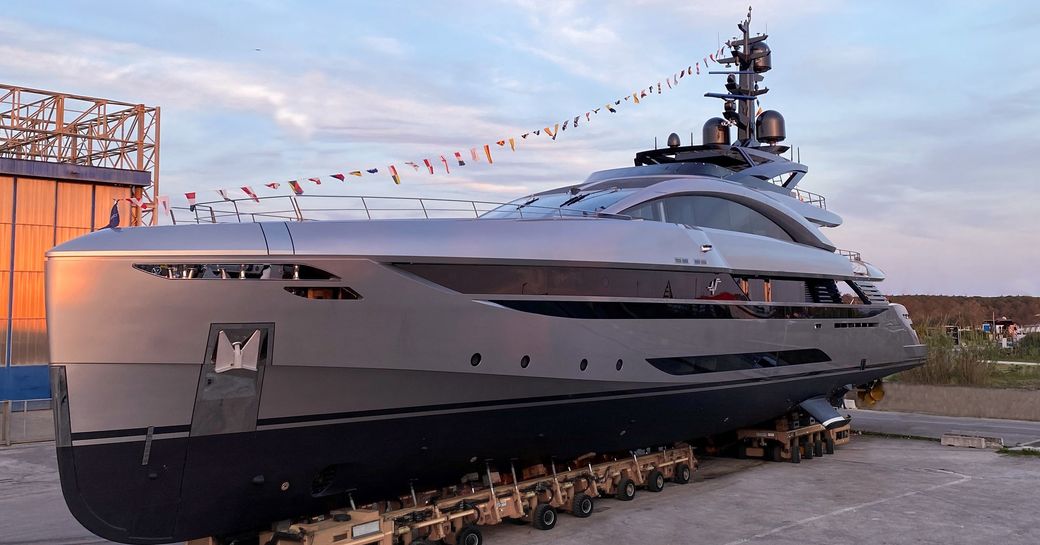
Federico Rossi, the Chief Operating Officer of Rossinavi, explains, "'No Stress Two is a hybrid vessel characterized by a strong sporty attitude. It is a high-performance superyacht with dual fuel: diesel and battery. Artificial Intelligence allows you to enjoy the electric experience on board to the fullest." And this is just the beginning, as Rossinavi plans to unveil even more advanced technology with the launch of the Sea Cat next year.
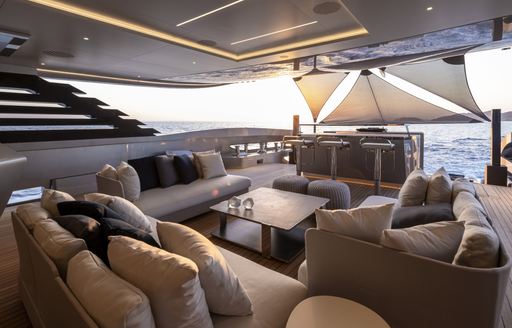
Beyond its groundbreaking technology, NO STRESS TWO boasts exceptional design features. A meticulous attention to detail has been employed in the study of space, evident in the comfortable walking area surrounding the 10 sqm pool in the bow. The open Beach Club, a standout highlight for the superyacht, includes a DJ station with a screen overlooking the area on the aft cockpit, providing the perfect setting for luxurious parties in the Mediterranean .
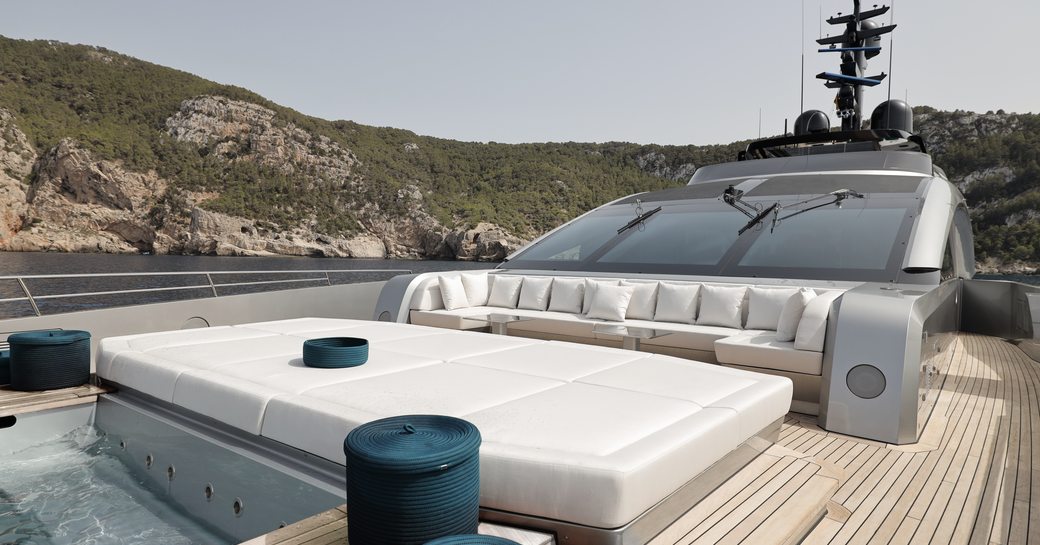
Stepping inside you'll be captivated by the elegant interiors. With a combination of refined details, precise alignments, and the use of natural and prestigious materials, the result is a sophisticated ambiance and an environment that emphasizes the indulgence of the superyacht lifestyle. Enrico Gobbi, the mastermind behind the interior design, explains, "The study of the hull openings and the superstructure was fundamental, to have a yacht with sporty lines without compromises, giving the interiors the maximum landscape view."

NO STRESS TWO marks an exciting turning point for the superyacht industry. With its innovative hybrid propulsion system and state-of-the-art design, this vessel represents a new way of navigating and experiencing the sea. As we sail towards a more sustainable future, NO STRESS TWO paves the way for a new generation of luxury yachts that prioritize both performance and environmental consciousness.
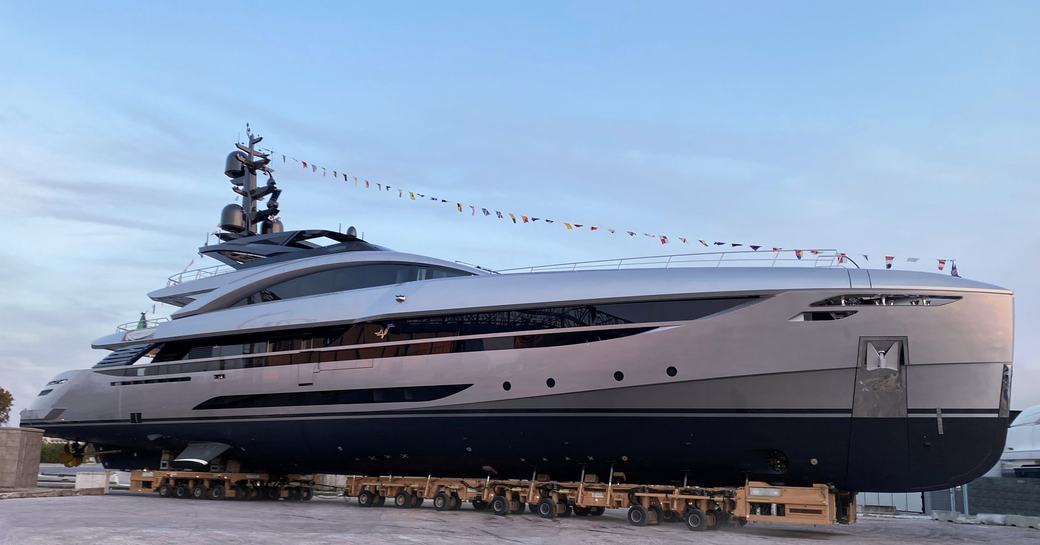
NO STRESS TWO is not currently available for charter, however, if you'd like to charter a yacht of a similar caliber take a look at all available crewed yacht charters .
Alternatively, speak to your preferred yacht charter broker today for more details on Rossinavi charter yachts .
Rossinavi charter yachts

48m Rossinavi 2014 / 2023
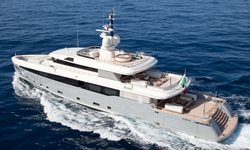
48m Rossinavi 2012 / 2022

39m Rossinavi 2015
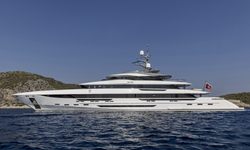
70m Rossinavi 2021

66m Rossinavi 2023

63m Rossinavi 2018
- READ MORE ABOUT:
- NO STRESS TWO
RELATED STORIES
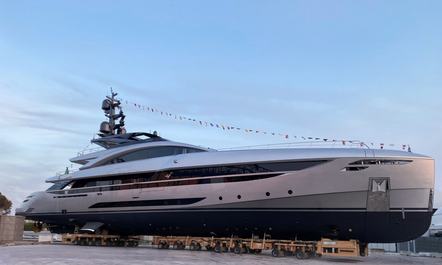
Previous Post
CRN ANNOUNCES 70m Project Thunderball
Motor yacht AIFER opens bookings for France yacht charters
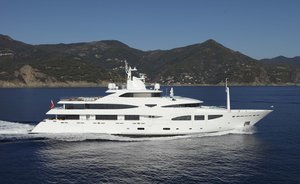
EDITOR'S PICK
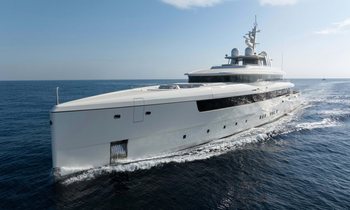
Latest News

14 May 2024
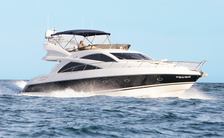
13 May 2024

- See All News
Yacht Reviews
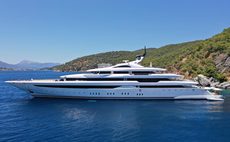
- See All Reviews

Charter Yacht of the week
Join our newsletter
Useful yacht charter news, latest yachts and expert advice, sent out every fortnight.
Please enter a valid e-mail
Thanks for subscribing
Featured Luxury Yachts for Charter
This is a small selection of the global luxury yacht charter fleet, with 3610 motor yachts, sail yachts, explorer yachts and catamarans to choose from including superyachts and megayachts, the world is your oyster. Why search for your ideal yacht charter vacation anywhere else?

136m | Lurssen
from $4,319,000 p/week ♦︎
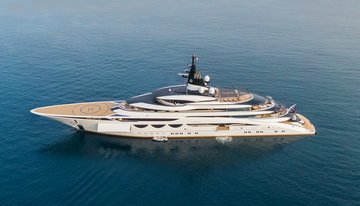
115m | Lurssen
from $2,808,000 p/week ♦︎
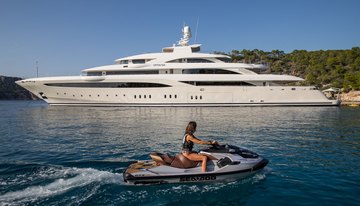
85m | Golden Yachts
from $972,000 p/week ♦︎
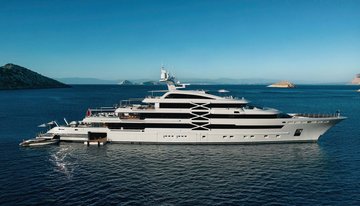
88m | Golden Yachts
from $1,188,000 p/week ♦︎
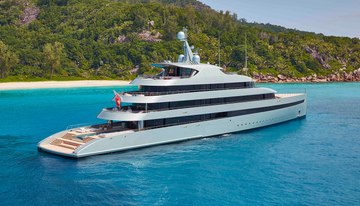
84m | Feadship
from $1,080,000 p/week ♦︎

93m | Feadship
from $1,512,000 p/week ♦︎
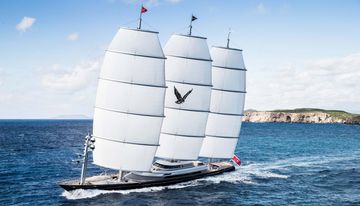
Maltese Falcon
88m | Perini Navi
from $490,000 p/week
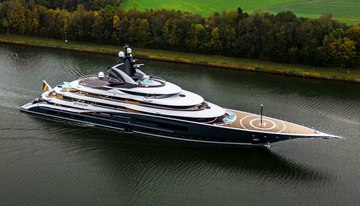
122m | Lurssen
from $3,000,000 p/week
As Featured In
The YachtCharterFleet Difference
YachtCharterFleet makes it easy to find the yacht charter vacation that is right for you. We combine thousands of yacht listings with local destination information, sample itineraries and experiences to deliver the world's most comprehensive yacht charter website.
San Francisco
- Like us on Facebook
- Follow us on Twitter
- Follow us on Instagram
- Find us on LinkedIn
- Add My Yacht
- Affiliates & Partners
Popular Destinations & Events
- St Tropez Yacht Charter
- Monaco Yacht Charter
- St Barts Yacht Charter
- Greece Yacht Charter
- Mykonos Yacht Charter
- Caribbean Yacht Charter
Featured Charter Yachts
- Maltese Falcon Yacht Charter
- Wheels Yacht Charter
- Victorious Yacht Charter
- Andrea Yacht Charter
- Titania Yacht Charter
- Ahpo Yacht Charter
Receive our latest offers, trends and stories direct to your inbox.
Please enter a valid e-mail.
Thanks for subscribing.
Search for Yachts, Destinations, Events, News... everything related to Luxury Yachts for Charter.
Yachts in your shortlist
- Nautic Shows
- America’s Cup
- Classic Yachts
- Motor Yachts
- Sailing Yachts
- Superyachts
- Yachts News
- Destinations
- Yacht Clubs
- Boat Racing
- Meta Yachts

Under the aegis of its collective Monaco, Capital of Advanced Yachting approach to build the future of yachting, Yacht Club de Monaco hosted a fascinating talk on artificial intelligence (AI) by the visionary Marco Landi, former Vice-President of Apple worldwide and Chairman of the Institut EuropIA.
In the YCM’s iconic venue combining tradition and modernity, Marco Landi shared his insights on the rapid evolution of AI, highlighting in particular its transformative role in contemporary society.
The conference began with an engaging introduction by Marco Landi, pointing out the recent advances in artificial intelligence and its expanding role in our daily lives. Mr Landi stressed the importance of understanding the ethical and social implications of this fast-changing technology.
“I am convinced artificial intelligence will change man’s thinking, perception and reality and in doing so will alter humanity’s history and identity” declared Marco Landi. “We’re already seeing how machines learn and apply logic that is beyond the scope of human reason. Even though humans will continue to control the world, societies have to cooperate not just to understand it but also to adapt,” he added.

The presentation explored concrete examples illustrating AI’s impact in areas as varied as mobility, health and crucially the nautical industry with the emergence of smart marinas and smart ports and the use of increasingly effective AI-aided navigation tools, demonstrating the versatility and revolutionary potential of this approach.
Much of the talk focused on discussing generative artificial intelligence. “ It’s a new breakthrough that could radically change the way we approach content creation, marketing, education and business,” said Marco Landi adding that “ education in schools will be radically affected and require rigorous monitoring by parents and teachers”.
The Q&A session that followed was an opportunity for Yacht Club de Monaco members to discuss issues with Marco Landi, further enhancing everyone’s understanding of current and future challenges posed by AI for our society. “ We must exploit the wealth of opportunities that artificial intelligence will create and prepare for a better life, a less polluted world and humans rediscovering values that make life worth living,” he concluded.
Artificial Intelligence will again be in the spotlight on 21/22 March at the 2nd Smart Yacht Rendezvous, organised by Yacht Club de Monaco during Monaco Ocean Week. “ We are integrating AI into our daily lives, sometimes without even realising it. Many solutions have already been developed in the yachting sector, tools that I hope will help us towards more sustainable yachting,” said YCM General Secretary Bernard d’Alessandri.
The Institut EuropIA invited everyone to attend the World Artificial Cannes Festival (WAICF), a global event on Artificial Intelligence taking place in Cannes from 8-10 February.
The Institut EuropIA , based in Sophia Antipolis, is a non-profit organisation that aims to raise awareness and educate the general public and businesses on the issues and challenges around artificial intelligence.
Founded in 2018 and chaired by Marco Landi, the Institute’s mission is to put humans and an ethical approach at the heart of AI in reflecting on the world’s future. The Institut EuropIA is at the crossroads of technological research, entrepreneurial initiatives and keynote international interdisciplinary meetings. It aims to provide a national and international showcase of cutting edge expertise and the artificial intelligence ecosystem of the Alpes-Maritimes, making it a ‘Land of AI’.
The ultimate goal is to prepare to respond to the challenges our society faces, particularly those related to the digital transition, via ethical AI that puts humans at the centre of its activities. Thanks to an open and friendly approach, the Institut EuropIA is able to capitalise on the diversity and collective intelligence of its members, drawing on a wide-ranging academic and economic network. It aims to increase the general public’s knowledge, generate employment and create opportunities for businesses.
- Artificial intelligence
- Yacht Club de Monaco

RELATED ARTICLES
Club members and people of the sea demand the government to act “urgently” to prevent the disappearance of the “club nautico ibiza”, oldest yacht club in the world announces annamarie fegan as new admiral, triple bay yacht club: saudi arabia to build major yacht club as part of its 2030 vision, sporting season set to launch at yacht club costa smeralda, yacht club de monaco: la belle classe academy in full swing, the yacht club costa smeralda reopening safely.
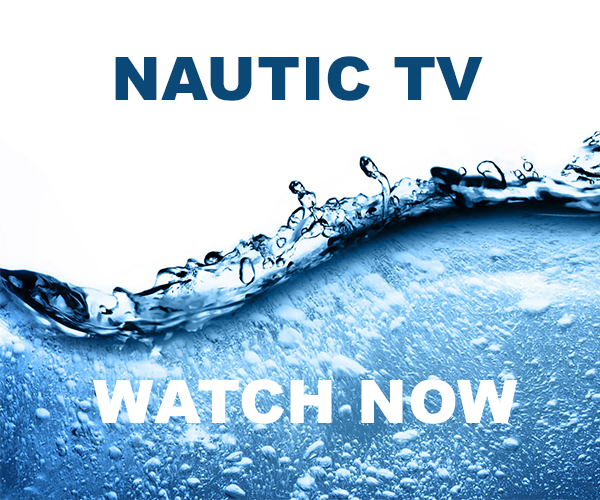
Subscribe to our newsletter
To be updated with all the latest news, offers and special announcements.
LATEST ARTICLES
Aussie’s come out firing on opening day of apex group bermuda sail grand prix, epic sailing conditions in barcelona for ineos britannia, luna rossa prada pirelli unveils next-gen foils and mast for america’s cup challenge, united states capsizes during bermuda’s practice racing, olympic dreams fulfilled: dramatic conclusions at the last chance regatta, rising tides at palmavela: the provezza’s triumph and a showcase of maritime mastery, editor picks, canadian beau lake introduces the tahoe ’14 and lugano ’14 electric runabouts, underwater adventure and exploration with deepflight’s super falcon 3s, driving performance on land and on water: 41′ amg carbon edition, popular posts, young designer of the year 2022: ioana valentina corcodel reveals 65m ophelia concept, mirabaud sailing video of the century: celebrating 2 decades of passion, superyacht the flying fox seized in the dominican republic, popular category.
- Regatta 823
- America's Cup 426
- Motor Yachts 264
- Boating 216
- Superyachts 186
- Sailing 179
- Yachts News 174
- Sailing Yachts 165

By SuperyachtNews 26 Dec 2020
AI and yachting
Mike blake, president of palladium technologies, on what the future of artificial intelligence will really look like….

Artificial intelligence (AI), which is the simulation of human intelligence, has become very prominent in the news, discussions and applications over the past five years. But the truth is that AI has been around for much longer, as I started developing AI applications back in 1987.
Today, we are surrounded in our daily lives with AI – in social media, online shopping, Google search engines, ridesharing, commercial flights (autopilots), banking and many more. Since it is difficult for most us to identify these implementations, and since we can’t distinguish between AI and non-AI systems, there are four basic forms of AI and I will explain them as follows:
1. Reactive machines – good examples are IBM’s Deep Blue, which beat the international chess grandmaster Garry Kasparov in the late 1990s.
2. Limited memory – machines that look into the past, such as parts of self-driving car software.
3. Theory of mind – these machines are more advanced and not only form representations of the world, but also entities in the world. It is this replication of how humans and creatures in the world have thoughts and emotions which affect their own behaviour.
4. Self awareness – this is the most advanced form of AI where these machines/systems develop a consciousness. Conscious beings are aware of themselves, know about their internal states and are able to predict feelings of others. The movies iRobot and Terminator are very good examples of this self awareness.
Why is there such excitement surrounding the first few levels of implementation of AI today? It is because we can use these AI systems/algorithms to handle massive amounts of data and learning, then developing patterns in this data, which we humans can’t do as efficiently. They operate without breaks, and they continue to learn at a speed of the computers that they operate on, 24/7. Good examples can be found in the medical field. In radiology, AI has achieved the ability to detect cancer in mammograms at a 96.6 per cent specificity level, which is much greater than the average radiologist today. It continues to learn at breakneck speeds, continually getting better with its discovery of cancer.
Now, how do we translate these systems and examples to our world of yachting?
The examples that I am about to give may frighten, or even anger, some people who might feel that their own professions are at risk. But in reality I believe that this assistance will allow us to be freed up to perform tasks that we are much better at.
This is an easy one as we move into self-learning autopilots, that are connected online with volumes of information about sea conditions, weather patterns, direct reporting from other ships and yachts, along with on-board navigation instrumentation. They can make much better decisions and never become distracted. This is happening today, in the shipping industry, in a limited fashion.
Cybersecurity
The only way to combat dynamically changing data attacks is to deploy sound and sophisticated AI appliances that morph their shields incautiously to protect the integrity of the yacht’s systems, and the owner’s data.
We are using AI routines in our security systems to understand the patterns of the yacht’s operation, identifying intrusions more quickly and immediately identifying the correct access to all areas of the yacht through facial recognition.
Alarm, monitoring and control (AMS) Another area that benefits from the use of AI algorithms. These algorithms move the AMS from a reactionary system to a truly forward-watching and preventive system.
Owner/guest services
By implementing AI to learn the patterns of the owner and guests, these systems can then anticipate their needs. Simply knowing their system vitals such as blood pressure, heart rate, temperature would allow an AI-driven guest services system to react precisely and immediately. I envision that robotics will be deployed in the future to interact directly with the owner and guests. Consistency in this service would be a major benefit, along with the ability to be available at all hours of the day and night to the varying schedules of each individual.
Entertainment systems
These systems, in general, have the label of AV (audio visual). I have a design for a ‘living yacht’, where the yacht reacts dynamically to the individual and/or individuals in an area of the yacht. Using AI learning we can change the environment in the area of the yacht to provide the entertainment experience that is matched directly to the audience, including their current temperament and past histories of likes, which will provide the ultimate user experience.
Approaching AI with the right attitude is very important, and it might be best to consider it as a tool with which to make our lives better and easier. As individuals, we will not stop the implementation of AI in our daily lives. If we embrace it, we can help steer the direction that it is headed so that it benefits us.
Profile links
Palladium Technologies, Inc
Join the discussion
To post comments please Sign in or Register
When commenting please follow our house rules
Click here to become part of The Superyacht Group community, and join us in our mission to make this industry accessible to all, and prosperous for the long-term. We are offering access to the superyacht industry’s most comprehensive and longstanding archive of business-critical information, as well as a comprehensive, real-time superyacht fleet database, for just £10 per month, because we are One Industry with One Mission. Sign up here .
Related news
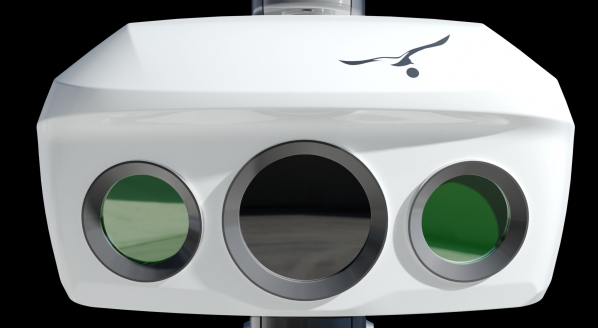
Collision avoidance by artificial intelligence
OSCAR uses thermal and colour cameras and artificial intelligence to prevent collisions with objects at sea

Integrating artificial intelligence on board
The integration of new technology will keep systems up to date with the needs of the crew using them
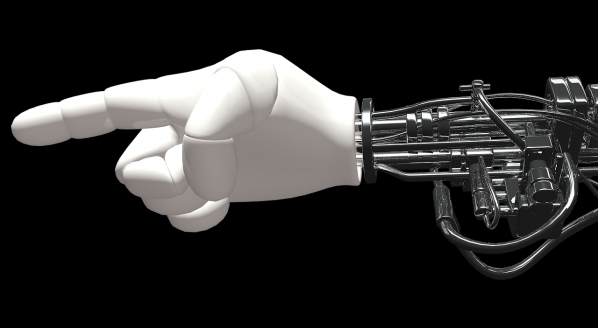
Keeping pace with technology
With technology evolving so quickly, we urgently need to rethink how we design, build and interact with our superyachts
4 years ago
7 years ago
Sign up to the SuperyachtNews Bulletin
Receive unrivalled market intelligence, weekly headlines and the most relevant and insightful journalism directly to your inbox.
Sign up to the SuperyachtNews Bulletin
The superyachtnews app.

Follow us on
Media Pack Request
Please select exactly what you would like to receive from us by ticking the boxes below:
SuperyachtNews.com
Register to comment
- THE PRINCESS PASSPORT
- Email Newsletter
- Yacht Walkthroughs
- Destinations
- Electronics
- Boating Safety

Will Artificial Intelligence Take Over Yachts and Yachting?
- By Jay Coyle
- Updated: April 18, 2018

I ’ve been thinking about something my boatbuilder pal Mike said as I attempted to shimmy beneath my wife Nelia’s high-tech automobile. Mike had been warning me about the dangers of artificial intelligence. “Soon, computers will no longer have any use for humans,” he said. “They’ll do away with us.”
I looked at the car and wondered if my time had come.
After years of twisting wrenches in the bowels of boats, I decided a few years back that I no longer cared to be handy. Ergo, when my wife’s “smart” car refused to budge, she summoned the dealer. The driver of the flatbed that collected it offered his opinion: “Pal, consider yourself lucky. I shoveled up the remains of one of these sleds that had spontaneously combusted. It took the guy’s house with it.”
I thought of Mike’s warning and wondered if perhaps the vehicle had been radicalized.
In our case, $1,500 later, the dealer assured my wife that her car would again respond to her commands. When it refused the next morning, I dutifully relented and grabbed my tools.
Years earlier, when I was coming up in the yacht business, an aging captain explained to me that, other than a handle of rum, there was nothing quite as useful as a handful of tools. “Always use the tools first,” he had instructed.
While rum is still useful, tools are of little use without diagnostic software to do the thinking. So I was surprised when my wife’s vehicle began cooperating after a few threatening gestures with my 9mm wrench. While the dealer claimed that the vehicle’s brain had been right to insist on repairs, I’m not sure. Could it be that given the threat of a fed-up, wrench-wielding human being, the vehicle decided to run off and fight another day?
Today’s boats and cars think alike because they come from the same school. Once upon a time, a marine diesel required only air and fuel, and a skipper with a screwdriver and wrench could ensure its delivery. Now a silicon brain controls an engine’s behavior and senses its moods. A skipper must be a code reader and capable of silicon brain surgery.
I’m no fogy. I’m an early adopter, for God’s sake. I was writing computer programs for yacht design in the 1980s. I get it: Computers have improved yachting. After a day at sea burping soot, my analog diesels left me looking like a coal miner. That said, I don’t want an angry engine deciding it doesn’t feel like full throttle when my boat is perched on the wrong side of a breaking sea.
I believe that humans should do the thinking and computers should do the work. Like my pal Mike, I’m not sure computers can be trusted, but I do think they’ll have reason enough to keep us around.
I predict the smart stuff aboard will conspire to benefit yachts of the future: “Sorry captain, the head reports you enjoyed pinot noir last night and you blew 0.09 into the VHF radio. The wine supply is locked, and the electronic controls will not respond. You’re beached, and I’m headed to the boatyard with your credit card.”
- More: Design , telltales , Yachts
- More Yachts
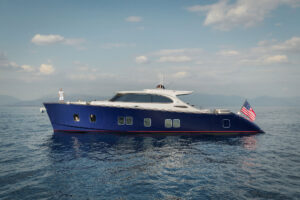
Zeelander 8 Yacht To Launch In July
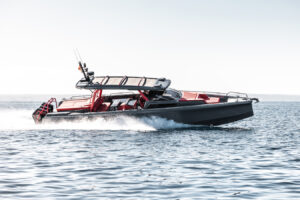
Brabus Unveils New Edition
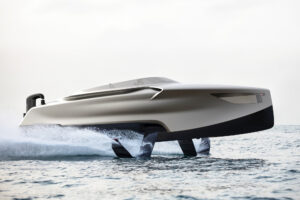
Six New Yachts for 2024
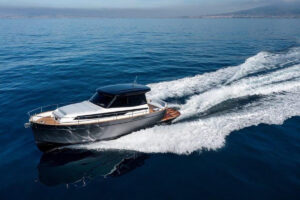
Apreamare Launches the Gozzo’s Cabin Version

Charter the America’s Cup
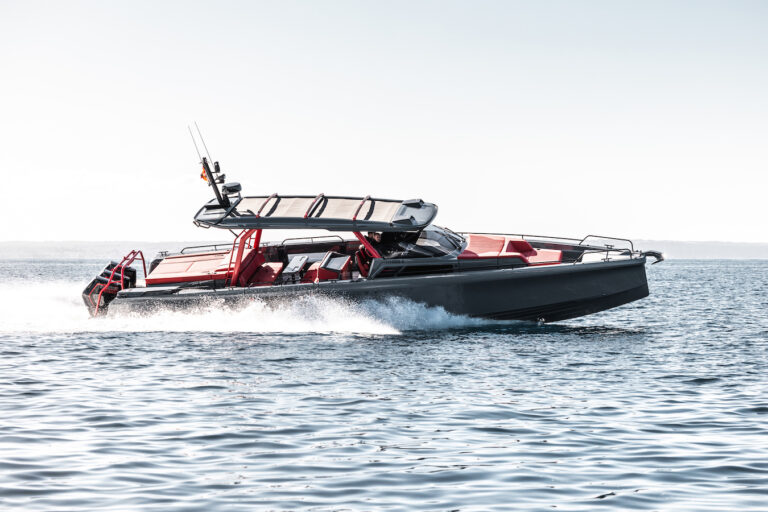
For Sale: Grand Banks 54
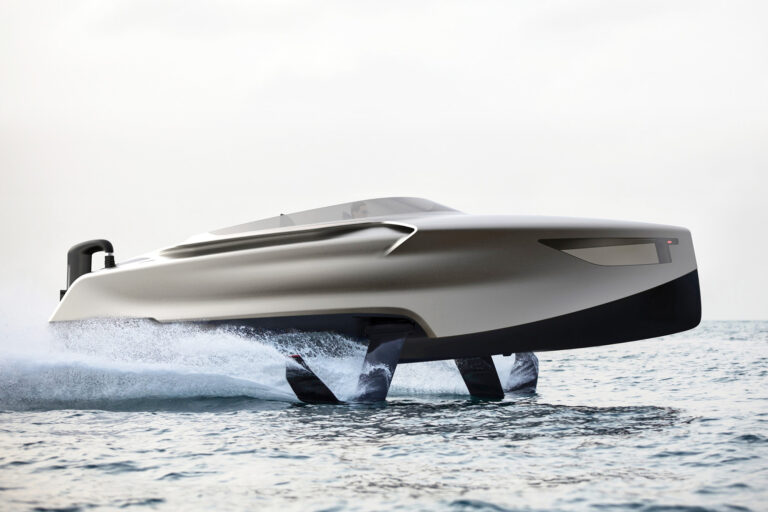
- Digital Edition
- Customer Service
- Privacy Policy
- Email Newsletters
- Cruising World
- Sailing World
- Salt Water Sportsman
- Sport Fishing
- Wakeboarding
Yacht Artificial Intelligence: Harnessing Yacht Artificial Intelligence for Business Growth
1. what is yacht artificial intelligence and why is it important for the yachting industry, 2. a list of the sources and citations that you used for your blog.
The yachting industry is undergoing a digital transformation, driven by the emergence of yacht artificial intelligence (YAI). YAI is the application of artificial intelligence (AI) techniques and technologies to yachts and their operations, enabling new levels of performance, efficiency, safety, and customer satisfaction. YAI can be seen as a subset of maritime AI, which encompasses all aspects of AI in the marine domain, such as navigation, communication, surveillance, and environmental monitoring. However, YAI has some unique characteristics and challenges that distinguish it from other domains of AI, such as:
- The complexity and diversity of yacht systems and components, which require integration and coordination of multiple AI solutions, such as computer vision, natural language processing , machine learning, and robotics.
- The high expectations and demands of yacht owners and guests, who seek personalized, luxurious, and seamless experiences on board, as well as privacy and security of their data and communications.
- The dynamic and uncertain nature of the marine environment, which poses various risks and uncertainties for yacht operations, such as weather, waves, currents, obstacles, and regulations.
- The ethical and social implications of YAI, which raise questions about the responsibility, accountability, and transparency of AI decisions and actions, as well as the impact of YAI on human workers, society, and the environment.
These characteristics and challenges make YAI a fascinating and important topic for the yachting industry, as it offers tremendous opportunities for innovation and growth . YAI can provide various benefits for different stakeholders in the yachting ecosystem, such as:
- For yacht owners and guests, YAI can enhance the quality and convenience of their yachting experience, by providing personalized recommendations, entertainment, and services, as well as ensuring safety, comfort, and privacy on board.
- For yacht operators and managers, YAI can improve the efficiency and profitability of yacht operations, by optimizing fuel consumption, maintenance, routing, and crew management, as well as reducing operational costs and risks.
- For yacht builders and designers, YAI can enable the creation of smarter and more sustainable yachts, by incorporating AI features and functionalities into yacht design, construction, and testing, as well as facilitating the adoption of green technologies and practices.
- For yacht brokers and charterers, YAI can increase the attractiveness and competitiveness of yacht offerings, by providing data-driven insights , marketing, and pricing, as well as enhancing customer loyalty and satisfaction .
These benefits illustrate the potential of YAI to transform the yachting industry and create new value for its stakeholders. However, to realize this potential, the yachting industry needs to overcome some barriers and challenges, such as:
- The lack of data and standards for YAI, which hinders the development and evaluation of YAI solutions, as well as their interoperability and compatibility across different yacht systems and platforms.
- The shortage of skills and talent for YAI, which limits the availability and quality of YAI experts and professionals, as well as their collaboration and communication with other yacht stakeholders.
- The resistance to change and adoption of YAI, which stems from the inertia, skepticism, and fear of some yacht stakeholders, who may perceive YAI as a threat to their interests, roles, and identities.
- The legal and regulatory uncertainty of YAI, which creates ambiguity and complexity for the compliance and liability of YAI solutions, as well as their alignment with ethical and social norms and values .
These barriers and challenges require the yachting industry to adopt a proactive and collaborative approach to YAI, by engaging and involving all relevant yacht stakeholders, such as owners, guests, operators, managers, builders, designers, brokers, charterers, regulators, researchers, and educators. By doing so, the yachting industry can foster a culture of innovation and excellence , and leverage YAI as a strategic asset and advantage for its future growth and success.
Like Mr. Trump, an entrepreneur and business man by trade, I have seen, first-hand, the importance of the 'Made in the U.S.A.' label. Mike Lindell
One of the most important aspects of writing a blog is to acknowledge the sources of information and inspiration that you have used. This not only shows respect for the original authors, but also enhances the credibility and reliability of your blog. Moreover, it allows your readers to follow up on the topics that interest them and learn more from the experts in the field. In this section, we will provide a list of the references that we have used for this blog, along with a brief explanation of how they relate to the main theme of yacht artificial intelligence.
The references are organized according to the following categories:
- Background and context : These are the sources that provide general information about the yacht industry, the challenges and opportunities it faces, and the role of artificial intelligence in transforming it. They help to set the stage for the blog and explain why yacht artificial intelligence is a relevant and timely topic.
- case studies and examples : These are the sources that showcase real-world applications and success stories of yacht artificial intelligence. They illustrate how different aspects of yacht business, such as design, manufacturing, marketing, sales, maintenance, and customer service, can benefit from artificial intelligence. They also highlight the best practices and lessons learned from the industry leaders and innovators.
- Trends and forecasts : These are the sources that analyze the current and future trends of yacht artificial intelligence, such as the market size, growth potential, competitive landscape, and customer preferences. They help to identify the opportunities and challenges for yacht businesses and provide insights and recommendations on how to leverage artificial intelligence for business growth .
The list of references is as follows:
1. Background and context :
- Yacht Industry Overview 2024 . This is a comprehensive report by the International Yacht Council (IYC) that provides an overview of the global yacht industry, including the market size, segmentation, drivers, barriers, and outlook. It also discusses the impact of COVID-19 on the industry and the recovery strategies. This source helps to understand the current state and future prospects of the yacht industry and the need for innovation and differentiation.
- Artificial Intelligence: The Next Frontier for Yachts . This is an article by Yacht World that introduces the concept and benefits of artificial intelligence for yachts. It explains how artificial intelligence can enhance the performance, safety, comfort, and convenience of yachts, as well as create new business opportunities and customer experiences. This source helps to establish the relevance and potential of yacht artificial intelligence and to spark the interest of the readers.
2. Case studies and examples :
- How AI is Revolutionizing Yacht Design . This is a case study by Yacht Harbour that showcases how AI is being used to optimize the design and engineering of yachts. It features the example of Oceanco, a leading yacht builder that uses AI to create customized and efficient yachts that meet the highest standards of quality and sustainability. This source helps to demonstrate how AI can improve the product development and innovation process of yacht businesses and create value for the customers.
- How AI is Enhancing Yacht Marketing and Sales . This is a case study by Yacht Charter Fleet that showcases how AI is being used to enhance the marketing and sales of yachts. It features the example of YachtEye, a smart platform that uses AI to provide interactive and immersive presentations of yachts to potential buyers and charterers. This source helps to demonstrate how AI can improve the customer engagement and conversion process of yacht businesses and create competitive advantage .
3. Trends and forecasts :
- Yacht artificial Intelligence market Report 2025 . This is a market research report by Grand View Research that provides an in-depth analysis of the global yacht artificial intelligence market, including the market size, growth rate, segmentation, drivers, challenges, opportunities, and competitive landscape. It also provides forecasts and projections for the market until 2025. This source helps to understand the trends and dynamics of the yacht artificial intelligence market and to identify the gaps and opportunities for yacht businesses.
- How AI will Shape the Future of Yachting . This is an article by Boat International that provides a visionary outlook on how AI will shape the future of yachting. It explores the emerging and disruptive technologies and applications of AI for yachts, such as autonomous navigation, predictive maintenance, smart entertainment, and personalized service. It also discusses the ethical and social implications of AI for yachting. This source helps to inspire and challenge the readers to think about the possibilities and implications of yacht artificial intelligence and to prepare for the future.
A list of the sources and citations that you used for your blog - Yacht Artificial Intelligence: Harnessing Yacht Artificial Intelligence for Business Growth
Read Other Blogs
1. Understanding the Annual Cap on Charitable Donations When it comes to making charitable...
1. Understanding the Strategic Vision: The CTO plays a crucial role in aligning technology...
In the realm of market analysis, the strategic application of simulation techniques can unveil a...
In the fast-paced world of startups, where agility and precision are paramount, the emergence of...
### Understanding Investment Risk Sensitivity Investing is like walking a tightrope between risk...
In recent years, the startup landscape has witnessed a transformative shift with the emergence of a...
In the quest to build a high-performing engineering culture, the initial steps taken by an...
Property training is not just about learning how to buy, sell, or rent properties. It is also a...
In the competitive landscape of business, intellectual property (IP) stands as a critical asset for...
UW’s student yacht club could end as university reimagines waterfront
The high cost of membership and boats probably makes joining a yacht club low on the priority list for many college students. But University of Washington students have been able to take part in one for just $39 per quarter and have full access to expensive boating equipment, lessons and time on the water.
That deal could come to an end as soon as this summer, as the university’s latest waterfront renovations threaten to shut down the 76-year-old Washington Yacht Club.
According to club members, students will lose out on a unique, affordable experience, but the university says it’s making the waterfront more equitable, opening it up to more students and a wider range of uses.
The Washington Yacht Club has been on the UW campus since 1948 and operates as a nonprofit as well as a registered student organization. The club’s goal, according to its website, is to “teach and promote sailing in a safe, inclusive, accessible, and affordable way.”
Currently, the club stores its fleet of 70 boats at the docks near Husky Stadium on the east side of campus, including dinghies, keelboats and high-performance catamarans.
The club will have to remove all of them by July 1 as the university tears down, rebuilds and repairs the docks.
“The main issue is that they are going to remove us either way, no matter what the footprint is or how that changes,” said Layla Airola, a UW junior and a spokesperson for the yacht club.
The docks, located in front of the Water Activities Center, need to be replaced as many of them “are nearing their end of life and have some safety hazards due to deterioration over time,” according to project documents.
Gregory Reinhardt, associate director for programming at UW’s recreation department, said the project will cost $2.54 million based on current projections.
Once the work is done by April 2025, the university won’t let the club return its fleet to the docks, save for maybe one boat, if it agrees to become a recreational club. Without a place to store its fleet, the yacht club will struggle to exist in its current form, members say.
Notably, the Washington Yacht Club says, the project will remove the dinghy docks, effectively shutting down the club’s small-boat sailing program, which often helps introduce beginners to the sport.
Nearby and also being renovated is the historic ASUW Shellhouse , the birthplace of the UW rowing program made famous by the book, and the recent George Clooney-directed movie, “The Boys in the Boat,” chronicling the team’s push to compete in the 1936 Olympics.
The 2023 film helped inspire the shell house project, funded by an $18.5 million fundraising campaign. When the remodel is finished in June 2026, the doors will roll open again, and the shell house will become a student and community gathering space.
Until recently, the student yacht club and other groups stored some equipment in the shell house. Airola argues the new vision for the shell house goes against the building’s origins.
“The ASUW Shellhouse’s history is centered around student athletics, yet students are being displaced to convert the building into an event venue,” Airola said in a text message.
The Washington Yacht Club isn’t the only student group displeased. Last month, the Associated Students of the University of Washington, the school’s student government, passed a resolution opposing the dock renovation as it would limit the yacht club’s ability to operate, according to The Daily, UW’s student newspaper .
The university contends the yacht club can continue to exist and has offered its members the option of becoming a recreational club. If they do, they’d be allowed to store one boat at the docks.
Reinhardt said none of the 38 active clubs the department oversees receives the same amenities the yacht club does. He said in an email the offer to make them a recreational club would make their experience “consistent with that of the other [registered student organizations] we support officially through Rec Club status.”
Reinhardt also suggested in an email to the yacht club the possibility that they could rent moorage nearby from Intercollegiate Athletics, though that option hadn’t been explored.
Airola said one boat is not enough to support the club’s approximately 300 student members. She acknowledged the club has more storage space than any other student recreation club on campus, but argues the scope of their organization warrants the space.
As the July deadline to remove their boats nears, Airola said the group is looking into other storage locations for its fleet. If the club can’t find a place, it may have to sell its boats.
“Our experience with the university has not been that they would like to keep us here,” said Renee Chien, a senior and the club’s rear commodore. “But we do offer a very unique experience for students.”
Most Read Local Stories
- Melinda French Gates resigns from Bill & Melinda Gates Foundation
- Bob's Your Uncle: 2 Bob Fergusons withdraw from WA governor's race
- Seattle church leads counterprotest in support of Israel on UW campus VIEW
- Four things to know about Seattle's plan to explore closing schools
- Bears in the North Cascades: What you should know if you spot one WATCH
The opinions expressed in reader comments are those of the author only and do not reflect the opinions of The Seattle Times.
Potential power and pitfalls of harnessing artificial intelligence for sleep medicine
Ai has potential uses in the sleep field for clinical applications, lifestyle management, and population health.
In a new research commentary, the Artificial Intelligence in Sleep Medicine Committee of the American Academy of Sleep Medicine highlights how artificial intelligence stands on the threshold of making monumental contributions to the field of sleep medicine. Through a strategic analysis, the committee examined advancements in AI within sleep medicine and spotlighted its potential in revolutionizing care in three critical areas: clinical applications, lifestyle management, and population health. The committee also reviewed barriers and challenges associated with using AI-enabled technologies.
"AI is disrupting all areas of medicine, and the future of sleep medicine is poised at a transformational crossroad," said lead author Dr. Anuja Bandyopadhyay, chair of the Artificial Intelligence in Sleep Medicine Committee. "This commentary outlines the powerful potential and challenges for sleep medicine physicians to be aware of as they begin leveraging AI to deliver precise, personalized patient care and enhance preventive health strategies on a larger scale while ensuring its ethical deployment."
According to the authors, AI has potential uses in the sleep field in three key areas:
- Clinical Applications :In the clinical realm, AI-driven technologies offer comprehensive data analysis, nuanced pattern recognition and automation in diagnosis, all while addressing chronic problems like sleep-related breathing disorders. Despite understated beginnings, the utilization of AI can offer improvements in efficiency and patient access, which can contribute to a reduction in burnout among health care professionals.
- Lifestyle Management :Incorporating AI also offers clear benefits for lifestyle management through the use of consumer sleep technology. These devices come in various forms like fitness wristbands, smartphone apps, and smart rings, and they contribute to better sleep health through tracking, assessment and enhancement. Wearable sleep technology and data-driven lifestyle recommendations can empower patients to take an active role in managing their health, as shown in a recent AASM survey, which reported that 68% of adults who have used a sleep tracker said they have changed their behavior based on what they have learned. But, as these AI-driven applications grow ever more intuitive, the importance of ongoing dialogue between patients and clinicians about the potential and limitations of these innovations remains vital.
- Population Health : Beyond individual care, AI technology reveals a new approach to public health regarding sleep. "AI has the exciting potential to synthesize environmental, behavioral and physiological data, contributing to informed population-level interventions and bridging existing health care gaps," noted Bandyopadhyay.
The paper also offers warnings about the integration of AI into sleep medicine. Issues of data privacy, security, accuracy, and the potential for reinforcing existing biases present new challenges for health care professionals. Additionally, reliance on AI without sufficient clinical judgment could lead to complexities in patient treatment.
"While AI can significantly strengthen the evaluation and management of sleep disorders, it is intended to complement, not replace, the expertise of a sleep medicine professional," Bandyopadhyay stated.
Navigating this emerging landscape requires comprehensive validation and standardization protocols to responsibly and ethically implement AI technologies in health care. It's critical that AI tools are validated against varied datasets to ensure their reliability and accuracy in all patient populations.
"Our commentary provides not just a vision, but a roadmap for leveraging the technology to promote better sleep health outcomes," Bandyopadhyay said. "It lays the foundation for future discussions on the ethical deployment of AI, the importance of clinician education, and the harmonization of this new technology with existing practices to optimize patient care."
- Sleep Disorders
- Obstructive Sleep Apnea
- Mental Health
- Information Technology
- Artificial Intelligence
- Circadian rhythm sleep disorder
- Sleep deprivation
- Sleep disorder
- Night terror
- Delayed sleep phase syndrome
- Rapid eye movement
- Narcolepsy (sleep disorder)
Story Source:
Materials provided by American Academy of Sleep Medicine . Note: Content may be edited for style and length.
Journal Reference :
- Anuja Bandyopadhyay, Margarita Oks, Haoqi Sun, Bharati Prasad, Sam Rusk, Felicia Jefferson, Roneil Gopal Malkani, Shahab Haghayegh, Ramesh Sachdeva, Dennis Hwang, Jon Agustsson, Emmanuel Mignot, Michael Summers, Daniel Fabbri, Maryann Deak, Matthew Anastasi, Andrew Sampson, Steve Van Hout, Azizi Seixas. Strengths, weaknesses, opportunities and threats of using AI-enabled technology in sleep medicine: a commentary . Journal of Clinical Sleep Medicine , 2024; DOI: 10.5664/jcsm.11132
Cite This Page :
Explore More
- Fastest Rate of CO2 Rise Over Last 50,000 Years
- Like Dad and Like Mum...all in One Plant
- What Makes a Memory? Did Your Brain Work Hard?
- Plant Virus Treatment for Metastatic Cancers
- Controlling Shape-Shifting Soft Robots
- Brain Flexibility for a Complex World
- ONe Nova to Rule Them All
- AI Systems Are Skilled at Manipulating Humans
- Planet Glows With Molten Lava
- A Fragment of Human Brain, Mapped
Trending Topics
Strange & offbeat.

The global authority in superyachting
- NEWSLETTERS
- Yachts Home
- The Superyacht Directory
- Yacht Reports
- Brokerage News
- The largest yachts in the world
- The Register
- Yacht Advice
- Yacht Design
- 12m to 24m yachts
- Monaco Yacht Show
- Builder Directory
- Designer Directory
- Interior Design Directory
- Naval Architect Directory
- Yachts for sale home
- Motor yachts
- Sailing yachts
- Explorer yachts
- Classic yachts
- Sale Broker Directory
- Charter Home
- Yachts for Charter
- Charter Destinations
- Charter Broker Directory
- Destinations Home
- Mediterranean
- South Pacific
- Rest of the World
- Boat Life Home
- Owners' Experiences
- Interiors Suppliers
- Owners' Club
- Captains' Club
- BOAT Showcase
- Boat Presents
- Events Home
- World Superyacht Awards
- Superyacht Design Festival
- Design and Innovation Awards
- Young Designer of the Year Award
- Artistry and Craft Awards
- Explorer Yachts Summit
- Ocean Talks
- The Ocean Awards
- BOAT Connect
- Between the bays
- Golf Invitational
- Boat Pro Home
- Superyacht Insight
- Global Order Book
- Premium Content
- Product Features
- Testimonials
- Pricing Plan
- Tenders & Equipment

Is AI the future for superyacht design?
What happens when you go from ‘computer aided’ to ‘computer generated’ design? New web-based artificial intelligence software that creates images from text input alone has been catching the attention of creatives around the world but does it have a place in yacht design? Andrew Johansson investigates...
New creative artworks have been appearing online in recent weeks that have been created in a way that is more akin to a science-fiction movie than reality. A handful of developers have been hard at work building artificial intelligence platforms that offer the creative community new opportunities. The two main contenders at the time of writing are Dall-E and MidJouney. These platforms offer a similar service with differing results but the principles remain the same. The web-based programmes create visuals by entering a simple sentence into a search bar before returning four images in a matter of seconds. While the results can vary significantly, some can be truly extraordinary.
“It forces you to verbalise your design ideas in an efficient and articulate way. Is it an Art Deco railing or is it an Art Deco railing with ornate flower metal work and a polished brass handrail? In short, you could call it targeted unpredictability,” says designer John Cantu of Cantu Design, the studio behind the in-build 38 metre Garfield, Westport Yachts’ W35 and the refit of 30 metre Redsky .
The American designer has access to both platforms, focusing more on the capabilities of Dall-E — created by OpenAI — and its potential to change the way in which design studios collect inspirational material, create moodboards, explore themes and shapes, and even begin the design process for the exterior or interior spaces of a yacht.
“We’ve been following Dall-E since its early development,” explains Cantu who was granted access to the V2 beta version at the beginning of August 2022. “We have been impressed by how this software thinks and creates art and believe it will be a powerful tool for every creative industry and probably many more. The OpenAI platform can also write articles, movie scripts and so on. What you end up with is a creative content generator that, paired with the right person, can produce incredible results that are unique to your description. There will undoubtedly be sceptics and those who won’t see the value in it but I think the majority of people will view it as an additional source of targeted inspiration.”
Cantu goes on to explain how initially the results he was getting were mixed. However, the more searches were performed, the quicker he began to understand what terms yielded the best results. “We were able to get it to draw a wide range of yachts, from the practical to the most audacious ideas,” says the designer. “It’s interesting how you can focus on the smallest detail or zoom out to a bigger picture.”
Jana Kleine-Kalmer, a freelance interior architect and artist who has worked in collaboration with Cantu Design, agrees. She explains that the devil is in the detail and depending on the description, you can get very targeted results. The more specific the description, the better, with the same being true on MidJourney. However, you also have to understand how the AI software interprets the words and structure of the sentence.
“I was curious to see how Dall-E would react to the complexity of interiors, with the countless different elements that we take for granted in any given environment,” says Kleine-Kalmer. “When we asked for a hotel bedroom, it would focus on the most common denominator of the space, such as a bed or table within a room. It did, however, create very detailed sequences for interior design styles or architectural periods. Results got more creative when we fed it with art history influences or contemporary styles like digital art.”
Dall-E compiles results by pulling information from the web and presents it in a new format. Those with access can use the material created with limited restrictions, as OpenAI stipulates that all images must be credited to their AI but does not assert copyright status over the images so the creator can use them as they see fit. However, as the technology draws on existing content, it is plausible to think that certain creations might potentially come close to an original. It is an aspect that OpenAI appears to be aware of with the inclusion of a complaints procedure for such an eventuality. Dall-E, which at the time of writing, is in the beta stage as the developer continues to refine its artificial general intelligence.
“Designers often make use of web-based content in the process of gathering inspiration as part of a number of sources,” says Cantu. “Whether that be from old French furniture books, walking through a gallery, Pinterest or design magazines, nothing is created in a vacuum. AI art is a unique avenue to this same process."
It is a point that creative director at Thirty C Rob Armstrong agrees with and like Cantu has been exploring the possibilities of Dall-E and MidJourney, focusing on the latter primarily. Working in collaboration with Mahdi Shirzadkhan, director at MS Yacht Design, the duo has had similar experiences. However, one of the main differences between the two platforms is that MidJourney allows the user to instantly refine and further develop the four results it delivers endlessly with a single click. The AI is also being developed with the ability to use your own imagery from which to create new visuals.
“MidJourney sources images from across the web, which it draws upon to build your AI creation but the platform is also changing so you can feed it your own images. I could get it to create something new but based on my work rather than sourcing from other things,” says Armstrong. Thirty C’s portfolio includes the exterior refit of 56 metre Galaxy in collaboration with Njord by Bergman Design House and the soon-to-be-delivered Navier 27. The English designer goes on to reveal the parallel between these AI platforms and a technique he has used for many years to generate new ideas using watercolours on paper.
“I’ll get some really basic lines down and work it up from there,” explains Armstrong. “The paint is doing the AI and you are seeing what’s within it, drawing on your knowledge or imagination to make something from it.” Using this method as an example, you can quickly see how the imagery created by AI platforms could be used and developed into real conceptual projects.
The limits of these platforms seem endless once you understand how to extract the most from them. However, how the market will view it and explore the ways to get the most out of it, will be key.
It comes as no surprise that free but less powerful platforms such as Starry AI, Dream by Wombo and Nightcafe have been released. However, the breadth of possibility and the results that you can achieve varies. With Google also rushing to join the market with their own platform called Imagen, it’ll be interesting to see how the market develops.
However, there are also those for whom this technology is not yet refined enough to be useful or, as co-founder of design studio Nuvolari Lenard, Dan Lenard explains, it is simply not a tool he’d choose to use at this time. “Software with true AI is something we are far from at this point in time,” says Lenard. “It simply cannot express the emotional component in the creative process. Our studio has always got more ideas than opportunities to build them — we have to reduce these to a final and ultimate proposal. We definitely don’t need any more ideas.”
The power of these platforms is extraordinary. Looking at the yacht sector, only time will tell if it will become a beneficial tool. Seeing how these AI platforms might be utilised once officially launched will be exciting to witness.
More stories
Most popular, from our partners, sponsored listings.
Artificial intelligence in strategy
Can machines automate strategy development? The short answer is no. However, there are numerous aspects of strategists’ work where AI and advanced analytics tools can already bring enormous value. Yuval Atsmon is a senior partner who leads the new McKinsey Center for Strategy Innovation, which studies ways new technologies can augment the timeless principles of strategy. In this episode of the Inside the Strategy Room podcast, he explains how artificial intelligence is already transforming strategy and what’s on the horizon. This is an edited transcript of the discussion. For more conversations on the strategy issues that matter, follow the series on your preferred podcast platform .
Joanna Pachner: What does artificial intelligence mean in the context of strategy?
Yuval Atsmon: When people talk about artificial intelligence, they include everything to do with analytics, automation, and data analysis. Marvin Minsky, the pioneer of artificial intelligence research in the 1960s, talked about AI as a “suitcase word”—a term into which you can stuff whatever you want—and that still seems to be the case. We are comfortable with that because we think companies should use all the capabilities of more traditional analysis while increasing automation in strategy that can free up management or analyst time and, gradually, introducing tools that can augment human thinking.
Joanna Pachner: AI has been embraced by many business functions, but strategy seems to be largely immune to its charms. Why do you think that is?
Subscribe to the Inside the Strategy Room podcast
Yuval Atsmon: You’re right about the limited adoption. Only 7 percent of respondents to our survey about the use of AI say they use it in strategy or even financial planning, whereas in areas like marketing, supply chain, and service operations, it’s 25 or 30 percent. One reason adoption is lagging is that strategy is one of the most integrative conceptual practices. When executives think about strategy automation, many are looking too far ahead—at AI capabilities that would decide, in place of the business leader, what the right strategy is. They are missing opportunities to use AI in the building blocks of strategy that could significantly improve outcomes.
I like to use the analogy to virtual assistants. Many of us use Alexa or Siri but very few people use these tools to do more than dictate a text message or shut off the lights. We don’t feel comfortable with the technology’s ability to understand the context in more sophisticated applications. AI in strategy is similar: it’s hard for AI to know everything an executive knows, but it can help executives with certain tasks.
When executives think about strategy automation, many are looking too far ahead—at AI deciding the right strategy. They are missing opportunities to use AI in the building blocks of strategy.
Joanna Pachner: What kind of tasks can AI help strategists execute today?
Yuval Atsmon: We talk about six stages of AI development. The earliest is simple analytics, which we refer to as descriptive intelligence. Companies use dashboards for competitive analysis or to study performance in different parts of the business that are automatically updated. Some have interactive capabilities for refinement and testing.
The second level is diagnostic intelligence, which is the ability to look backward at the business and understand root causes and drivers of performance. The level after that is predictive intelligence: being able to anticipate certain scenarios or options and the value of things in the future based on momentum from the past as well as signals picked in the market. Both diagnostics and prediction are areas that AI can greatly improve today. The tools can augment executives’ analysis and become areas where you develop capabilities. For example, on diagnostic intelligence, you can organize your portfolio into segments to understand granularly where performance is coming from and do it in a much more continuous way than analysts could. You can try 20 different ways in an hour versus deploying one hundred analysts to tackle the problem.
Predictive AI is both more difficult and more risky. Executives shouldn’t fully rely on predictive AI, but it provides another systematic viewpoint in the room. Because strategic decisions have significant consequences, a key consideration is to use AI transparently in the sense of understanding why it is making a certain prediction and what extrapolations it is making from which information. You can then assess if you trust the prediction or not. You can even use AI to track the evolution of the assumptions for that prediction.
Those are the levels available today. The next three levels will take time to develop. There are some early examples of AI advising actions for executives’ consideration that would be value-creating based on the analysis. From there, you go to delegating certain decision authority to AI, with constraints and supervision. Eventually, there is the point where fully autonomous AI analyzes and decides with no human interaction.
Because strategic decisions have significant consequences, you need to understand why AI is making a certain prediction and what extrapolations it’s making from which information.
Joanna Pachner: What kind of businesses or industries could gain the greatest benefits from embracing AI at its current level of sophistication?
Yuval Atsmon: Every business probably has some opportunity to use AI more than it does today. The first thing to look at is the availability of data. Do you have performance data that can be organized in a systematic way? Companies that have deep data on their portfolios down to business line, SKU, inventory, and raw ingredients have the biggest opportunities to use machines to gain granular insights that humans could not.
Companies whose strategies rely on a few big decisions with limited data would get less from AI. Likewise, those facing a lot of volatility and vulnerability to external events would benefit less than companies with controlled and systematic portfolios, although they could deploy AI to better predict those external events and identify what they can and cannot control.
Third, the velocity of decisions matters. Most companies develop strategies every three to five years, which then become annual budgets. If you think about strategy in that way, the role of AI is relatively limited other than potentially accelerating analyses that are inputs into the strategy. However, some companies regularly revisit big decisions they made based on assumptions about the world that may have since changed, affecting the projected ROI of initiatives. Such shifts would affect how you deploy talent and executive time, how you spend money and focus sales efforts, and AI can be valuable in guiding that. The value of AI is even bigger when you can make decisions close to the time of deploying resources, because AI can signal that your previous assumptions have changed from when you made your plan.
Joanna Pachner: Can you provide any examples of companies employing AI to address specific strategic challenges?
Yuval Atsmon: Some of the most innovative users of AI, not coincidentally, are AI- and digital-native companies. Some of these companies have seen massive benefits from AI and have increased its usage in other areas of the business. One mobility player adjusts its financial planning based on pricing patterns it observes in the market. Its business has relatively high flexibility to demand but less so to supply, so the company uses AI to continuously signal back when pricing dynamics are trending in a way that would affect profitability or where demand is rising. This allows the company to quickly react to create more capacity because its profitability is highly sensitive to keeping demand and supply in equilibrium.
Joanna Pachner: Given how quickly things change today, doesn’t AI seem to be more a tactical than a strategic tool, providing time-sensitive input on isolated elements of strategy?
Yuval Atsmon: It’s interesting that you make the distinction between strategic and tactical. Of course, every decision can be broken down into smaller ones, and where AI can be affordably used in strategy today is for building blocks of the strategy. It might feel tactical, but it can make a massive difference. One of the world’s leading investment firms, for example, has started to use AI to scan for certain patterns rather than scanning individual companies directly. AI looks for consumer mobile usage that suggests a company’s technology is catching on quickly, giving the firm an opportunity to invest in that company before others do. That created a significant strategic edge for them, even though the tool itself may be relatively tactical.
Joanna Pachner: McKinsey has written a lot about cognitive biases and social dynamics that can skew decision making. Can AI help with these challenges?
Yuval Atsmon: When we talk to executives about using AI in strategy development, the first reaction we get is, “Those are really big decisions; what if AI gets them wrong?” The first answer is that humans also get them wrong—a lot. [Amos] Tversky, [Daniel] Kahneman, and others have proven that some of those errors are systemic, observable, and predictable. The first thing AI can do is spot situations likely to give rise to biases. For example, imagine that AI is listening in on a strategy session where the CEO proposes something and everyone says “Aye” without debate and discussion. AI could inform the room, “We might have a sunflower bias here,” which could trigger more conversation and remind the CEO that it’s in their own interest to encourage some devil’s advocacy.
We also often see confirmation bias, where people focus their analysis on proving the wisdom of what they already want to do, as opposed to looking for a fact-based reality. Just having AI perform a default analysis that doesn’t aim to satisfy the boss is useful, and the team can then try to understand why that is different than the management hypothesis, triggering a much richer debate.
In terms of social dynamics, agency problems can create conflicts of interest. Every business unit [BU] leader thinks that their BU should get the most resources and will deliver the most value, or at least they feel they should advocate for their business. AI provides a neutral way based on systematic data to manage those debates. It’s also useful for executives with decision authority, since we all know that short-term pressures and the need to make the quarterly and annual numbers lead people to make different decisions on the 31st of December than they do on January 1st or October 1st. Like the story of Ulysses and the sirens, you can use AI to remind you that you wanted something different three months earlier. The CEO still decides; AI can just provide that extra nudge.
Joanna Pachner: It’s like you have Spock next to you, who is dispassionate and purely analytical.
Yuval Atsmon: That is not a bad analogy—for Star Trek fans anyway.
Joanna Pachner: Do you have a favorite application of AI in strategy?
Yuval Atsmon: I have worked a lot on resource allocation, and one of the challenges, which we call the hockey stick phenomenon, is that executives are always overly optimistic about what will happen. They know that resource allocation will inevitably be defined by what you believe about the future, not necessarily by past performance. AI can provide an objective prediction of performance starting from a default momentum case: based on everything that happened in the past and some indicators about the future, what is the forecast of performance if we do nothing? This is before we say, “But I will hire these people and develop this new product and improve my marketing”— things that every executive thinks will help them overdeliver relative to the past. The neutral momentum case, which AI can calculate in a cold, Spock-like manner, can change the dynamics of the resource allocation discussion. It’s a form of predictive intelligence accessible today and while it’s not meant to be definitive, it provides a basis for better decisions.
Joanna Pachner: Do you see access to technology talent as one of the obstacles to the adoption of AI in strategy, especially at large companies?
Yuval Atsmon: I would make a distinction. If you mean machine-learning and data science talent or software engineers who build the digital tools, they are definitely not easy to get. However, companies can increasingly use platforms that provide access to AI tools and require less from individual companies. Also, this domain of strategy is exciting—it’s cutting-edge, so it’s probably easier to get technology talent for that than it might be for manufacturing work.
The bigger challenge, ironically, is finding strategists or people with business expertise to contribute to the effort. You will not solve strategy problems with AI without the involvement of people who understand the customer experience and what you are trying to achieve. Those who know best, like senior executives, don’t have time to be product managers for the AI team. An even bigger constraint is that, in some cases, you are asking people to get involved in an initiative that may make their jobs less important. There could be plenty of opportunities for incorporating AI into existing jobs, but it’s something companies need to reflect on. The best approach may be to create a digital factory where a different team tests and builds AI applications, with oversight from senior stakeholders.
The big challenge is finding strategists to contribute to the AI effort. You are asking people to get involved in an initiative that may make their jobs less important.
Joanna Pachner: Do you think this worry about job security and the potential that AI will automate strategy is realistic?
Yuval Atsmon: The question of whether AI will replace human judgment and put humanity out of its job is a big one that I would leave for other experts.
The pertinent question is shorter-term automation. Because of its complexity, strategy would be one of the later domains to be affected by automation, but we are seeing it in many other domains. However, the trend for more than two hundred years has been that automation creates new jobs, although ones requiring different skills. That doesn’t take away the fear some people have of a machine exposing their mistakes or doing their job better than they do it.
Joanna Pachner: We recently published an article about strategic courage in an age of volatility that talked about three types of edge business leaders need to develop. One of them is an edge in insights. Do you think AI has a role to play in furnishing a proprietary insight edge?
Yuval Atsmon: One of the challenges most strategists face is the overwhelming complexity of the world we operate in—the number of unknowns, the information overload. At one level, it may seem that AI will provide another layer of complexity. In reality, it can be a sharp knife that cuts through some of the clutter. The question to ask is, Can AI simplify my life by giving me sharper, more timely insights more easily?
Joanna Pachner: You have been working in strategy for a long time. What sparked your interest in exploring this intersection of strategy and new technology?
Yuval Atsmon: I have always been intrigued by things at the boundaries of what seems possible. Science fiction writer Arthur C. Clarke’s second law is that to discover the limits of the possible, you have to venture a little past them into the impossible, and I find that particularly alluring in this arena.
AI in strategy is in very nascent stages but could be very consequential for companies and for the profession. For a top executive, strategic decisions are the biggest way to influence the business, other than maybe building the top team, and it is amazing how little technology is leveraged in that process today. It’s conceivable that competitive advantage will increasingly rest in having executives who know how to apply AI well. In some domains, like investment, that is already happening, and the difference in returns can be staggering. I find helping companies be part of that evolution very exciting.
Explore a career with us
Related articles.

Strategic courage in an age of volatility

Bias Busters Collection
- Election 2024
- Entertainment
- Newsletters
- Photography
- Personal Finance
- AP Investigations
- AP Buyline Personal Finance
- AP Buyline Shopping
- Press Releases
- Israel-Hamas War
- Russia-Ukraine War
- Global elections
- Asia Pacific
- Latin America
- Middle East
- Election Results
- Delegate Tracker
- AP & Elections
- Auto Racing
- 2024 Paris Olympic Games
- Movie reviews
- Book reviews
- Personal finance
- Financial Markets
- Business Highlights
- Financial wellness
- Artificial Intelligence
- Social Media
Intel exec on bringing artificial intelligence into the workplace
(AP Illustration/Jenni Sohn)
- Copy Link copied
NEW YORK (AP) — Artificial intelligence is just about everywhere you look these days — including the workplace.
That means training staff about the technology and using it responsibly is critical. It’s a tall order, especially as the commercialization of generative AI continues its rapid growth. Now some tech players have kickstarted initiatives in hopes of meeting that need.
Christy Pambianchi, chief people officer at Intel, recently spoke with The Associated Press about how the semiconductor chip maker is expanding AI education programming beyond the company’s walls — as well as best practices around implementing AI in a workforce from an HR perspective. The conversation has been edited for clarity and length.
Q: How have conversations about AI in the workforce evolved since you joined Intel in August, 2021?
A: Intel’s products are part of the AI innovation cycle that’s happening on a continuum. But this technology is also transforming the world of work — so it’s neat to contemplate both.
I think AI became a much bigger part of the conversation around the workforce, particularly generative AI, starting about a year ago. The HR community and many large companies have engaged in the AI continuum over the last number of years, but the acceleration right now can be seen in the growing adoption rates of people who have experimented with or used generative AI tools.
Q: What steps is Intel taking to help educate workers about AI?
A: We pay a lot of attention to the education space — through programs focused on equipping current and future workforce participants with the appropriate skills to use AI technology both impactfully and responsibly.
In our “Digital Readiness” program, we’re collaborating in over 28 countries with more than 100 public-private partnerships to bring AI awareness programing around the world. We’ve also developed something called “AI for Workforce” — where we try to deliver content and also job readiness.
Q: Tell me more about the ‘AI for Workforce’ initiative.
A: Intel has created over 500 hours of free AI content for community colleges across the U.S. — which can then be added to an existing curriculum or used to help develop new certifications.
Maricopa County Community College District, for example, worked with us to launch a two-year AI Associate degree program. And these things can then be brought to the employment community as valid credentials for hiring talent.
Q: How can the industry break down access barriers to this kind of technology?
A: Some of what we try to do with these programs is lower the barrier of entry to AI. We try really hard to create content and programs that meet people where they’re at — and help drive them to try this technology.
Scaling content to community colleges, which we know is the main access point for post-secondary education in the United States, is key to our “AI for Workforce” program. And 40% of schools participating in this initiative are designated Minority-Serving institutions.
Q: How can workplaces utilize what AI has to offer while keeping safety and ethical concerns about this technology in mind?
A: Any technology has to be implemented responsibly, and AI is no different.
At Intel, we’ve published a set of principles for the responsible use of AI — and there’s been similar initiatives in the HR community across industries. I think one underlying premise that has to pull through is: Human at the center. AI and generative AI can augment work, but humans should be the decision makers.
The first thing is to be transparent with your employees and engage them in the process. It’s important to reach out to your employee base for ideas on how AI can drive greater outcomes in their jobs — and leverage those voices while applying this technology to advance the wider goals of the company.
Artificial intelligence hitting labour forces like a "tsunami" - IMF Chief
- Medium Text

Sign up here.
Reporting by John Revill Editing by Dave Graham
Our Standards: The Thomson Reuters Trust Principles. New Tab , opens new tab
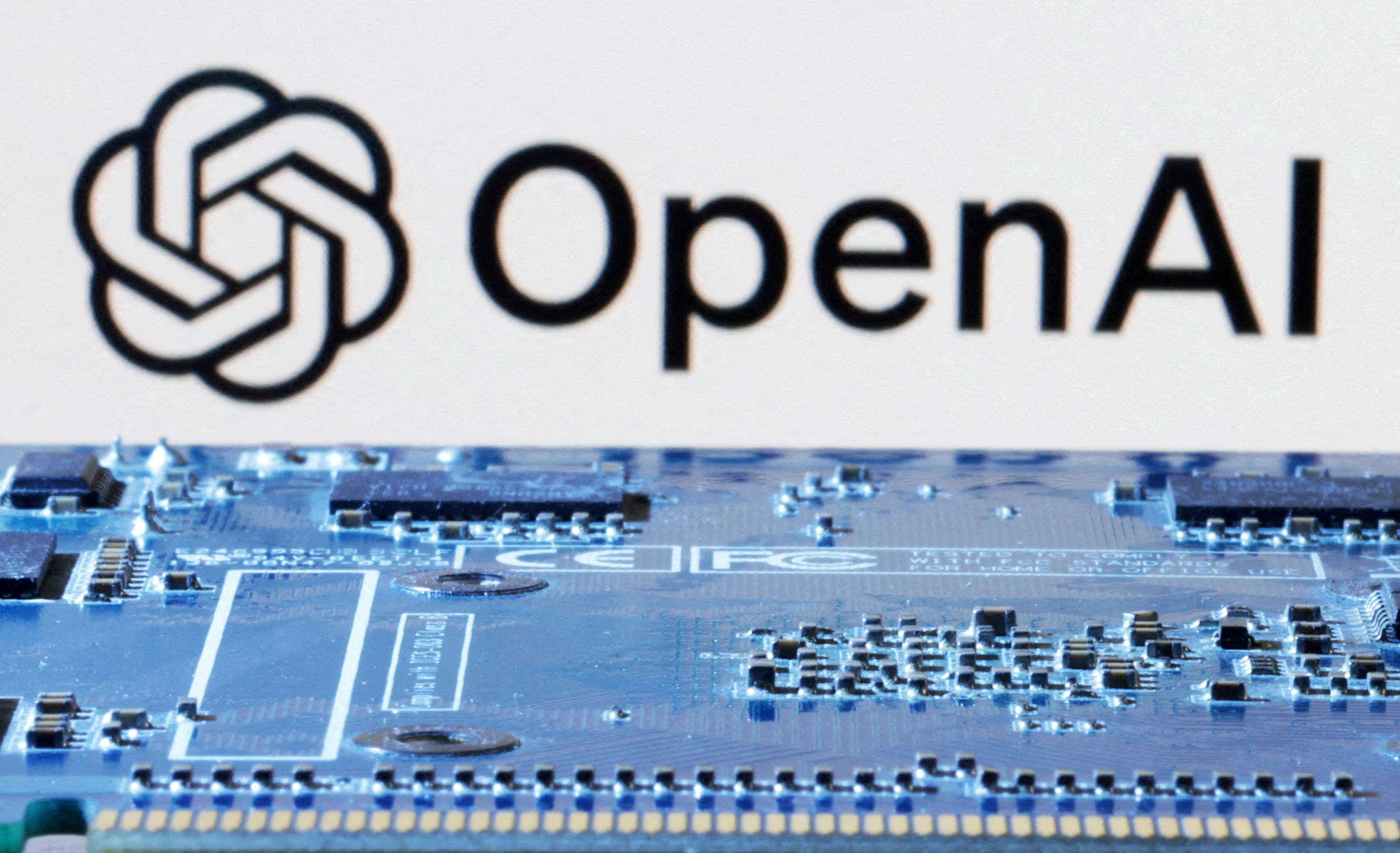
Technology Chevron

GameStop and AMC surge evokes 2021 meme stocks saga
Shares of GameStop and AMC jumped nearly 40% each in premarket trading on Tuesday, and are on track to extend gains from a day earlier when a series of posts from "Roaring Kitty" rekindled a rally reminiscent of the meme stocks trading frenzy.


IMAGES
VIDEO
COMMENTS
She operates as a 'virtual yacht manager' ensuring increased safety on board. Celine Robins, the Global Yacht Management Director of IYC, has commented on the significance of BLUE: 'This is the first time in the world that artificial intelligence is brought into the yachting industry and to yacht management. That is extremely revolutionary.
First introduced at BOAT International's Life Under Sail conference in November 2019, OSCAR is a collision-avoidance system of night vision and colour cameras and an artificial-intelligence processor that can tie into a vessel's autopilot (or throttles, too, in a motor yacht). Invented by Raphaël Biancale, it spots floating, stationary or semi-submerged objects, uses AI to assess their ...
Artificial Intelligence (AI) is the ability for technology to gather, synthesise, then act upon information. Machine learning means that this intelligence is refined further, as a computer gets better and better at its task, until it can imitate - or even surpass - human endeavour. Which naturally raises questions.
Explore the transformative impact of Artificial Intelligence (AI) on yacht operations and management. This article delves into how AI is integrated into various yacht systems, from navigation and safety to energy management and maintenance. Understand how AI technologies can enhance predictive capabilities, automate processes, and improve decision-making on board. Whether you are tech-savvy or ...
Imagine a fleet of concept yachts straight out of Tolkien's Middle-earth, or a jellyfish-inspired sailing boat with billowing tendril-like sails. In the world of computer-generated yacht design, artificial intelligence (AI) is less blue-sky thinking, more DreamWorks Animation, executed in the blink of an eye.
That's not the only example of the changing role technology is taking in new yacht projects. When it comes to artificial intelligence - about which the philosophical and technological debate is currently raging - in many ways yachts already bear its evolution as sensors on every element of equipment and system start to analyse status and progression to provide predictive maintenance.
How AI is Transforming the Superyacht and Business Aviation Industries. For two industries that have much in common, the difference in the adoption of artificial intelligence on private jets versus AI integration on superyachts is stark. While the aviation industry has been using artificial intelligence in its engines for almost 25-30 years now ...
Armstrong is one of the many yacht designers and naval architects who have been exploring AI as a tool to aid in the superyacht design process. Other designers have been less keen on embracing AI, warning it could ring the death knell for creativity. Credit: Jordan Nathan Bamforth/Midjourney. The yachting industry's varied opinions on AI are ...
As pioneers in the marine industry, 26 North Yachts is always on the cutting edge of technological advancements, and Artificial Intelligence (AI) is no exception. AI has massive potential in reshaping the yacht industry - from making trip planning a breeze, optimizing fuel calculations, and streamlining yacht management, to personalizing ...
TEMPO will be a study in all vessel systems where artificial intelligence can be used. The name, TEMPO, is tied to the uptick in operational tempo that the AI will make possible through enhanced reliability and operational availability, meaning that owners and guest will be able to spend more quality time onboard enjoying all that yachting can ...
The Adonis concept yacht is a Numarine 78 with onboard systems that work, in part, based on artificial intelligence. Courtesy Numarine. Founding partners at Furrion, an innovations company based in Indiana, met while working as mega-yacht crew — giving them a hands-on chance to see what technology worked, and what might be improved, out on the water.
DLBA has selected a 58m superyacht concept to develop internally as an autonomous yacht. The result, TEMPO, will be a study in all vessel systems where artificial intelligence can be used to enhance an owner's experience onboard. The name of the concept is tied to the uptick in operational tempo that the AI will make possible through enhanced ...
Unveiled in April 2023, NO STRESS TWO is not your ordinary yacht. With its intelligent hybrid propulsion system, this stunning motor yacht offers five operation modes, dual power systems, and a fast displacement aluminum hull. But what truly sets NO STRESS TWO apart is its integration of Artificial Intelligence, which optimizes electric mode efficiency to provide an unparalleled cruising ...
Edwards utilises artificial intelligence technology (originating from The University of Southampton) to reduce the typical cost and manpower that is required to create a yacht concept. AI interpretation of Leonardo Da Vinci's superyacht design created with NightCafe. Through the use of Olesinski AI, thousands of design solutions can be ...
DLBA Naval Architects. 860 Greenbrier Circle, Suite 201. Chesapeake. Virginia 23320. USA. T: 757-545-3700. E: [email protected]. Loading... Together with DLBA Naval Architects, we find out what artificial intelligence means for the superyachts of the future.
A superyacht optimized with artificial intelligence in every system. DLBA has selected a 58m superyacht concept to develop internally as an autonomous yacht. The result, Tempo, will be a study in all vessel systems where artificial intelligence can be used to enhance an owner's experience onboard. The name of the concept is tied to the uptick ...
Under the aegis of its collective Monaco, Capital of Advanced Yachting approach to build the future of yachting, Yacht Club de Monaco hosted a fascinating talk on artificial intelligence (AI) by the visionary Marco Landi, former Vice-President of Apple worldwide and Chairman of the Institut EuropIA.. In the YCM's iconic venue combining tradition and modernity, Marco Landi shared his insights ...
Artificial intelligence (AI), which is the simulation of human intelligence, has become very prominent in the news, discussions and applications over the past five years. But the truth is that AI has been around for much longer, as I started developing AI applications back in 1987. ... These systems, in general, have the label of AV (audio ...
Steve Haefele. I 've been thinking about something my boatbuilder pal Mike said as I attempted to shimmy beneath my wife Nelia's high-tech automobile. Mike had been warning me about the dangers of artificial intelligence. "Soon, computers will no longer have any use for humans," he said. "They'll do away with us.".
One of the main challenges that startups face is how to innovate, collaborate, and learn effectively in a fast-paced and competitive environment. To address this challenge, many startups are turning to Yacht Artificial Intelligence (Yacht AI), a cutting-edge technology that leverages the power of data, machine learning, and natural language processing to provide smart solutions for various ...
- Yacht Artificial Intelligence market report 2025. This is a market research report by Grand View Research that provides an in-depth analysis of the global yacht artificial intelligence market, including the market size, growth rate, segmentation, drivers, challenges, opportunities, and competitive landscape. ...
With the Yacht Artificial Intelligence Advisor, buyers can enjoy a streamlined and informed decision-making process, finding the perfect vessel to embark on their nautical adventures. However, we acknowledge the presence of several issues and errors within our current system. As we develop a new version, we invite feedback and suggestions from ...
The high cost of membership and boats probably makes joining a yacht club low on the priority list for many college students. But University of Washington students have been able to take part in ...
The second rapidly growing artificial intelligence stock billionaires have been piling into as they sell shares of semiconductor titan Nvidia is social media maven Pinterest (PINS-0.36%). Four top ...
Apr. 7, 2022 — A new artificial intelligence-based approach can predict, significantly more accurately than a doctor, if and when a patient could die of cardiac arrest. The technology, built on ...
High-level envoys from the United States and China are set to meet in Geneva for talks about artificial intelligence including the risks of the technology and ways to set shared standards to manage it. The meeting Tuesday is billed as an opening exchange of views in an inter-governmental dialogue on AI agreed during a meeting between U.S ...
Dall-E, which at the time of writing, is in the beta stage as the developer continues to refine its artificial general intelligence. Credit: Cantu Design x DALL-E "Designers often make use of web-based content in the process of gathering inspiration as part of a number of sources," says Cantu.
Yuval Atsmon: When people talk about artificial intelligence, they include everything to do with analytics, automation, and data analysis. Marvin Minsky, the pioneer of artificial intelligence research in the 1960s, talked about AI as a "suitcase word"—a term into which you can stuff whatever you want—and that still seems to be the case.
NEW YORK (AP) — Artificial intelligence is just about everywhere you look these days — including the workplace. That means training staff about the technology and using it responsibly is critical. It's a tall order, especially as the commercialization of generative AI continues its rapid growth. Now some tech players have kickstarted ...
Artificial intelligence is likely to impact 60% of jobs in advanced economies and 40% of jobs around the world in the next two years, Georgieva told an event in Zurich.